61 Narrow Hallway Decorations to Maximize Style in Small Spaces
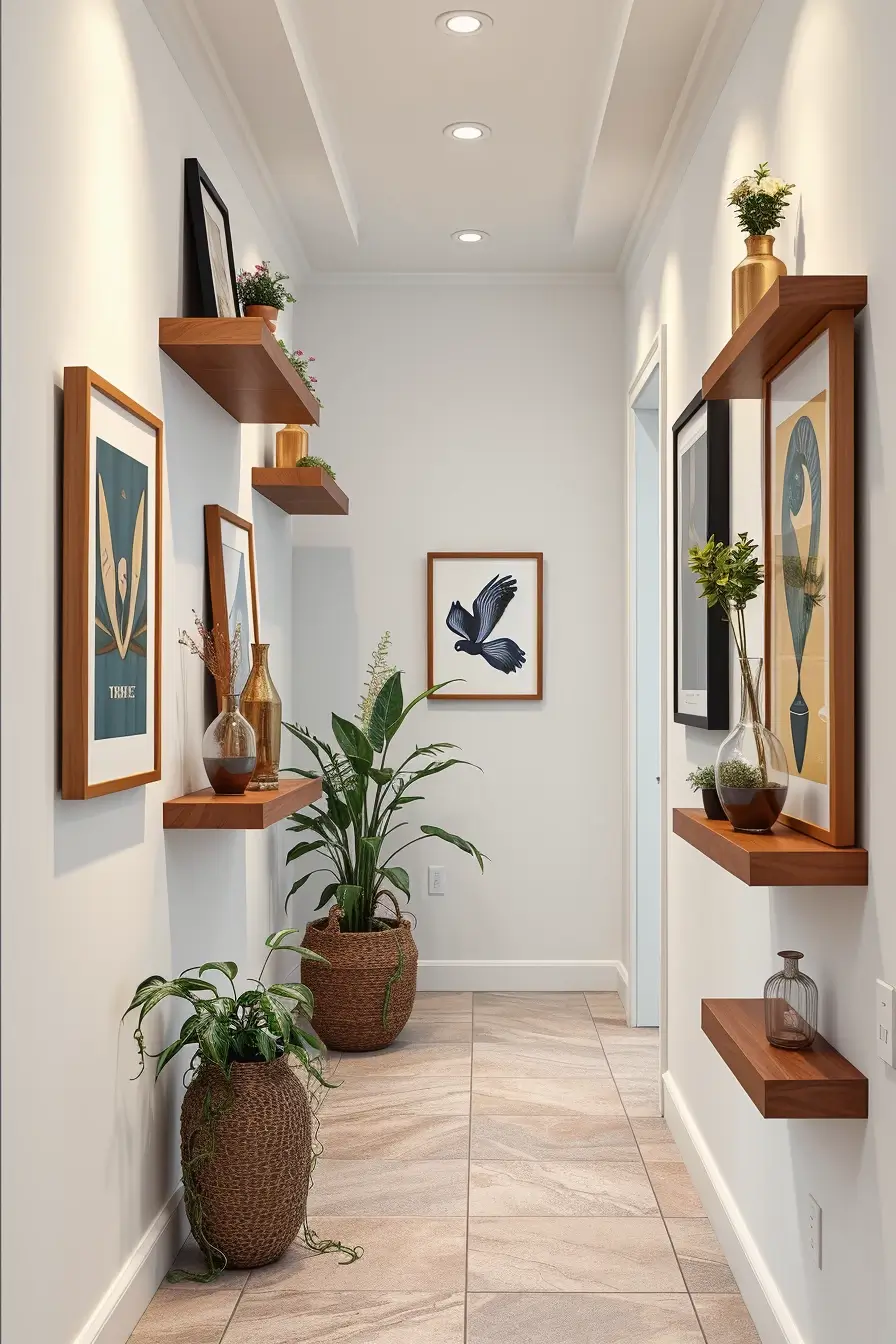
You battle to create a charming functional yet fashionable appearance in your compact hallway. The transformation of an understated space into functional beauty remains your concern. The following article presents effective narrow hallway decoration ideas suitable for every residential setting including apartments and traditional family homes. The proper application of light together with color and furniture selection enables you to achieve total transformation of your narrow corridors.
Add Depth With Mirrors in Narrow Hallways
According to my experience strategic mirror placement stands as the quickest method to expand narrow hallways. Mirrors act as more than light reflectors because they create an illusion of expanded space which opens up restricted corridors. My recommendation includes installing a single large mirror across a hallway wall or multiple smaller mirrors to create an artistic effect. The method provides practical depth expansion while saving space in the room.
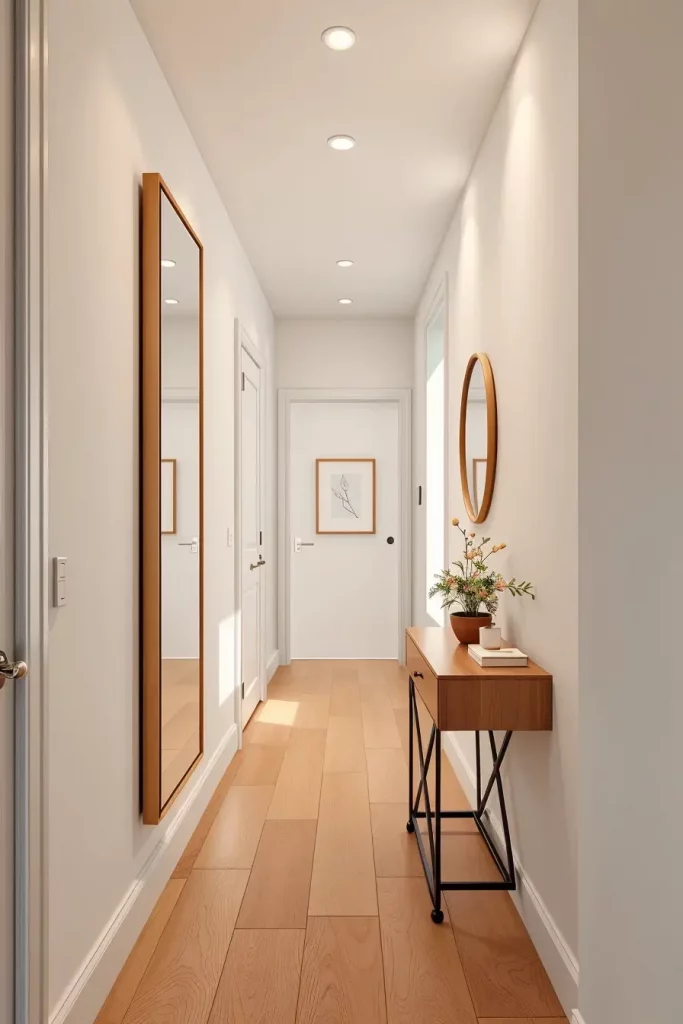
The right mirror selection for narrow hallways demands long rectangular shapes that match the vertical dimensions of the space. Mirrors that come in framed designs serve dual purposes of decorative enhancement. The hallway ends receive a statement mirror installation while multiple mirrors run in a row against the walls. The frames made from wood or metal assist in uniting the space with its decorative theme.
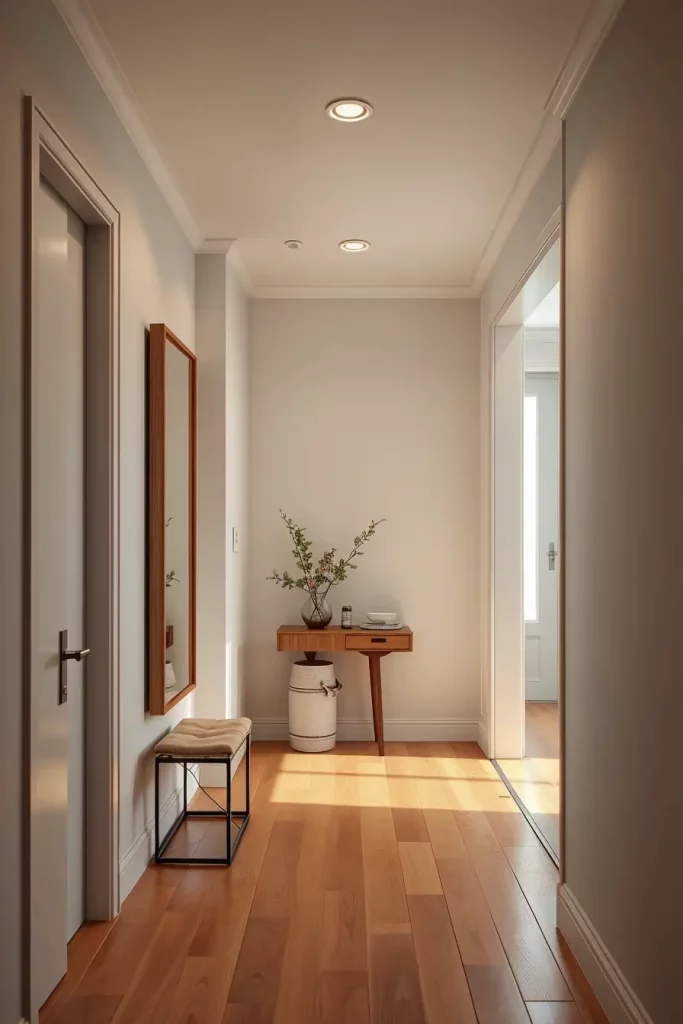
Light-colored walls combined with mirrors have been the most effective approach for me when improving space perception. The placement of mirrors opposite windows or lighting fixtures allows them to reflect and multiply the amount of sunlight entering darker spaces according to Architectural Digest. Such fixtures work best in older residences and apartment buildings which receive minimal sunlight.
The setup can be further improved by installing small picture lights and LED strips which will produce a gentle illumination around the mirror. The installation of small picture lights or LED strips around the mirror would enhance its appearance and provide functional illumination at night.
Maximize Natural Light With Glass Doors and Panels
Most older and small-sized homes lack natural light that reaches their hallways. The solution I often apply to this problem involves installing glass panels either within doorways or by using full or frosted glass door alternatives. The glass elements allow other rooms to share their light with the hallway space while still maintaining privacy.
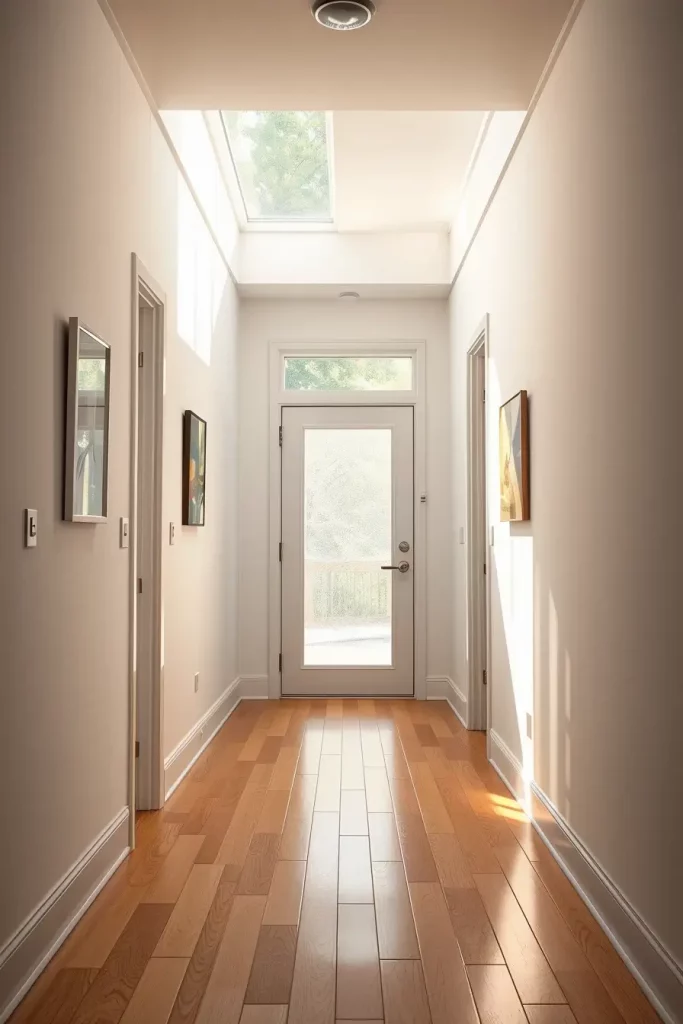
The combination of frosted glass doors spanning from floor to ceiling with adjacent spaces works along with vertical slits added to wooden door panels. Clear glass is the best option when privacy issues do not exist. The removal of doors by homeowners enables the installation of transom windows above entryways to enhance light sharing between rooms.
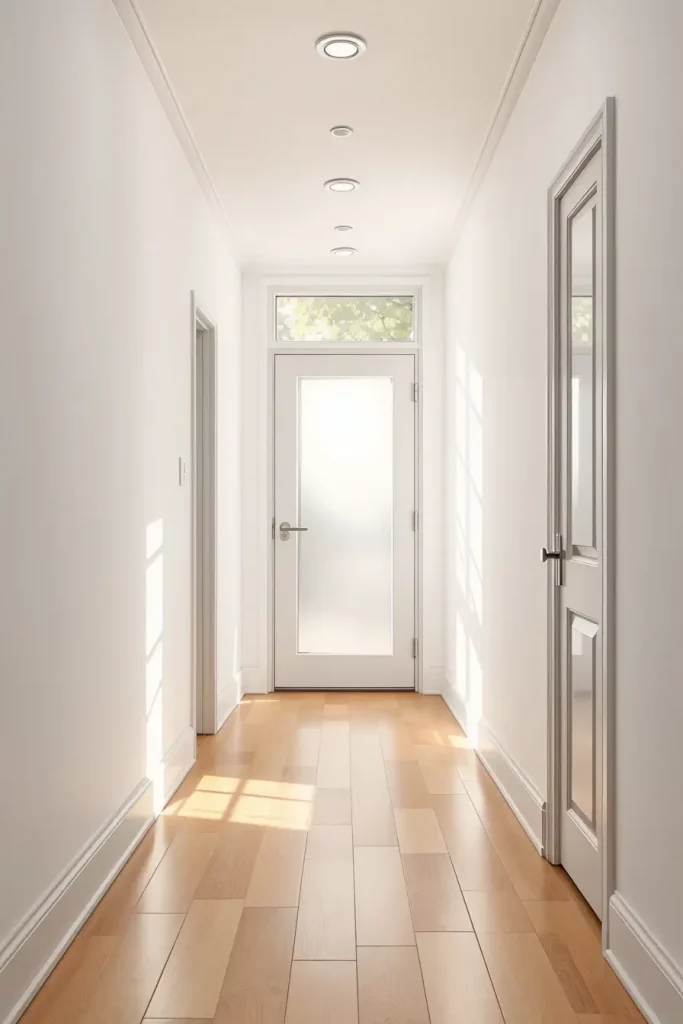
The transformation of my hallway space became possible when I installed a frosted glass door at its conclusion. The hallway extended in length while becoming brighter and its connection to other house areas improved significantly. Elle Decor published an article about glass as a design element that “guides the eye and light across closed-off areas” which luxury apartments commonly employ.
The addition of glass side panels to the main door or a narrow skylight in the ceiling would enhance the flow of natural light when the hallway is located on an upper floor. Small modifications will help you bring natural light into strategic areas.
Use Vertical Space With Tall Slim Shelving Units
Vertical storage requires tall slim shelving units which I consider the best solution for narrow areas. The shelves grant plentiful storage potential while maintaining free walking space to avoid traffic limitations. The shelves direct visual attention toward the ceiling which makes the hallway appear taller.
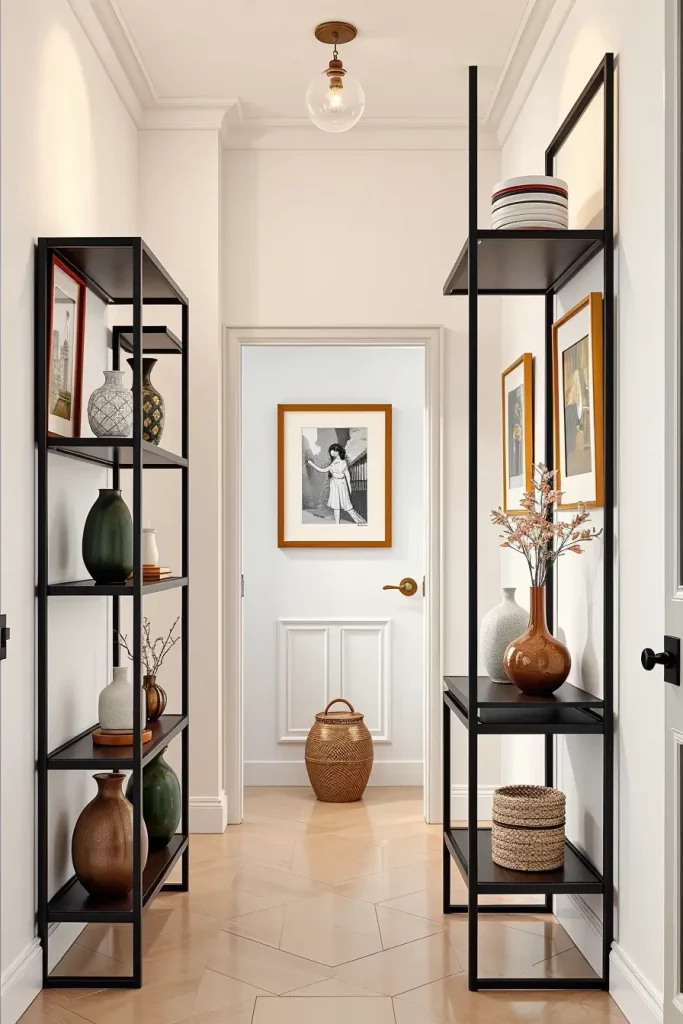
Shelves should not exceed 8–10 inches in depth according to my recommendation. Rungs and rungs shelves are appropriate for relaxed spaces but modular floating shells function best in contemporary interior designs. These shelves enable you to showcase vases together with framed art or use them as personal item storage containers through baskets.
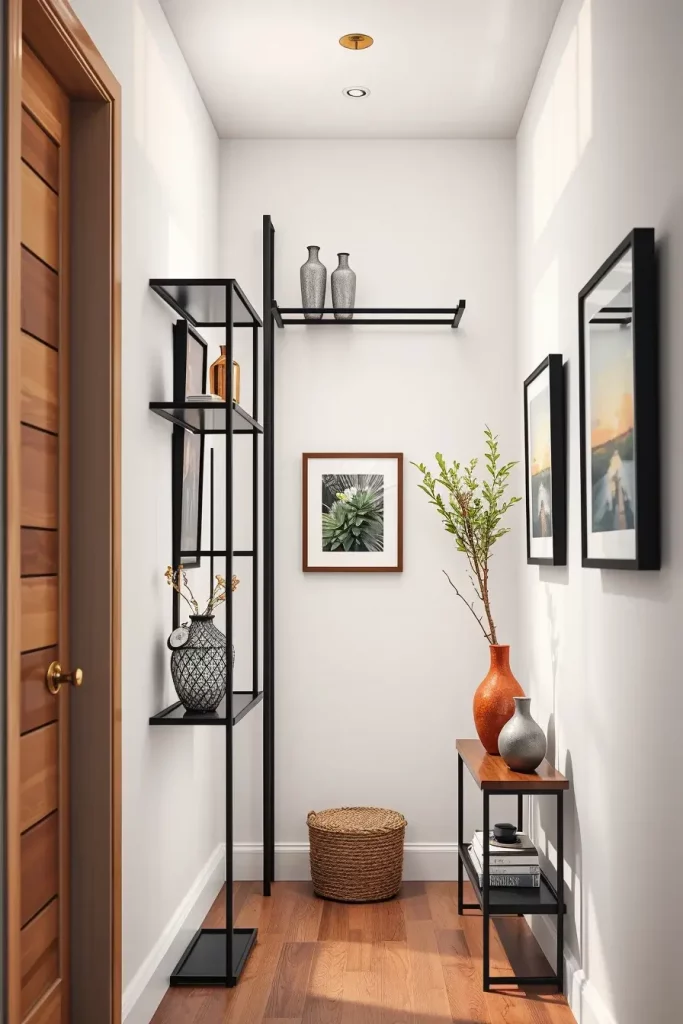
Vertical shelving integration through personal projects has proven to be an effective solution for hallway decluttering. The system functions as an alternative to heavy furniture and maintains unobstructed surfaces. House Beautiful identifies vertical storage as “one of the most underused space-saving tricks in home design” that works best for hallways and entryways.
The visual appeal can be improved by adding LED strip lighting behind shelves or by painting the wall behind them in a contrasting color. This approach creates separation through sight while maintaining space depth without overwhelming the area.
Install Slim Console Tables With Storage
Slim console tables establish the best combination of aesthetics and useability for narrow hallway spaces. The shelf surface provides decorative and functional purposes while occupying minimal floor space. My selection of tables extends to those that measure less than 10 inches in depth while positioned against the longest wall.

The ideal storage console tables feature one or two drawers which serve as perfect spaces to hide keys wallets and sunglasses. Some of my home designs include placing baskets at the base of console tables to store shoes and dog leashes. A stylish organized vignette forms when you place the table next to a mirror or artwork above it.
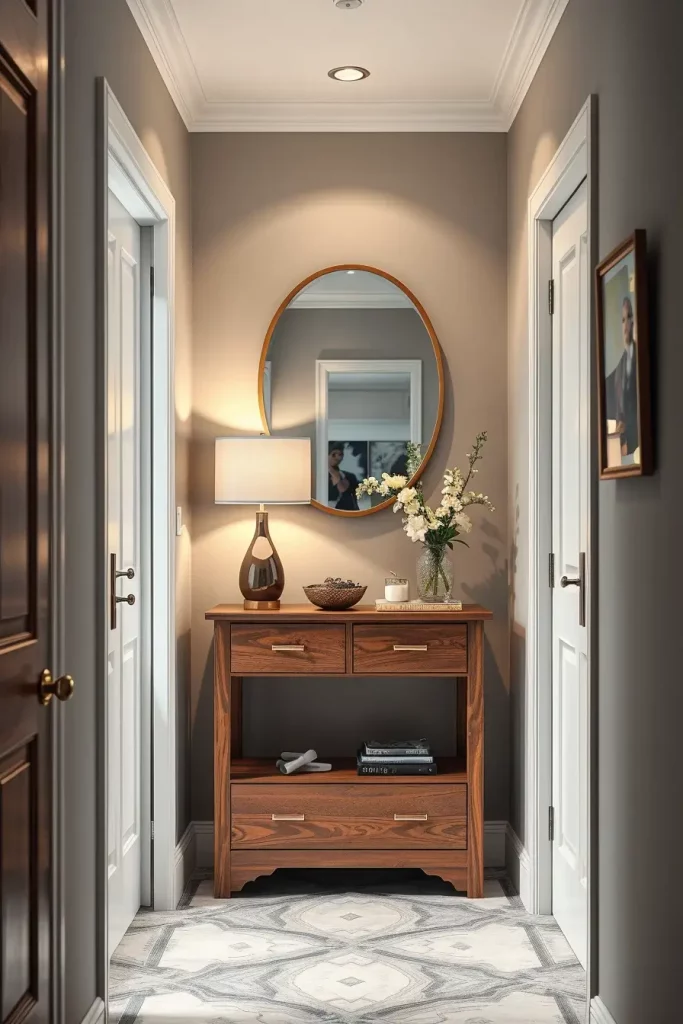
A walnut-finish console table stands in my hallway where I placed a ceramic bowl along with a candle and narrow lamp on top. The valuable features of warmth and functionality cannot be replaced. Small spaces benefit from console tables which present minimalist designs together with layered textures according to Better Homes & Gardens’ recommendation.
I would like to see multifunctional tables that feature extendable surfaces or flip-top panels as an improvement to this setup. The hallway gains valuable storage space from a console that transforms into a workspace or dressing area.
Opt for Light-Colored Walls to Expand the Space
The immediate effect of selecting pale wall colors in a confined hallway area creates an expanded appearance. My choice for hallway walls includes soft tones such as warm white and eggshell and light taupe and pale gray. Natural and artificial light reflects better from these wall colors which creates an effect of expanded and brighter hallway space.
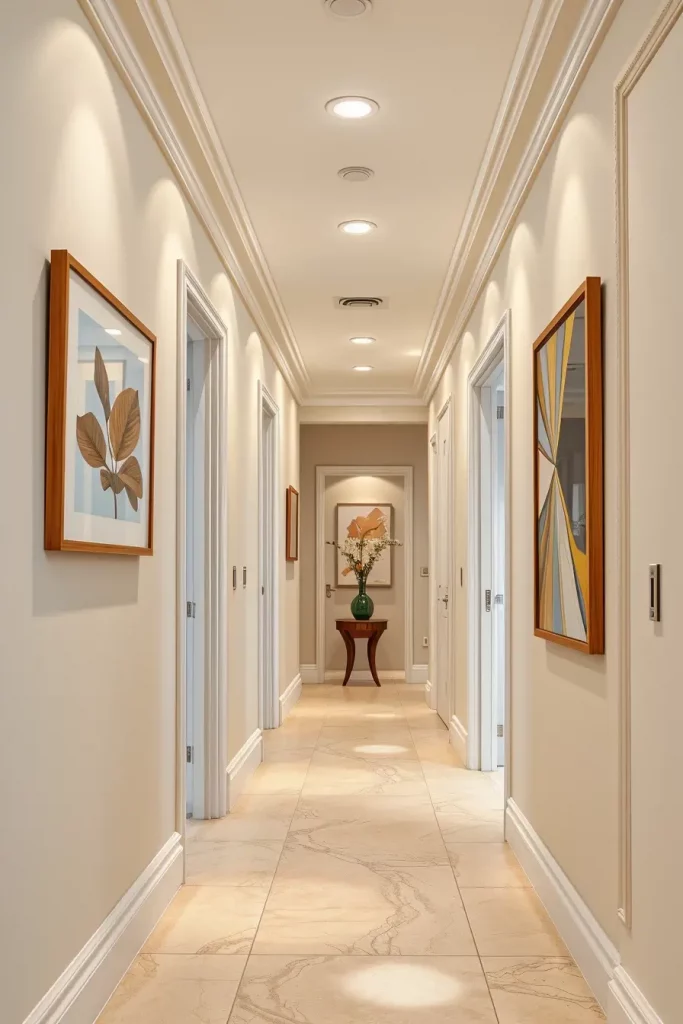
I select satin or semi-gloss paint finishes because they enhance reflection without being too noticeable. The space achieves a double benefit of expanded appearance and cleaner feel through this technique. Beadboard panels with a light color will provide vertical texturing while keeping the visual weight minimal.
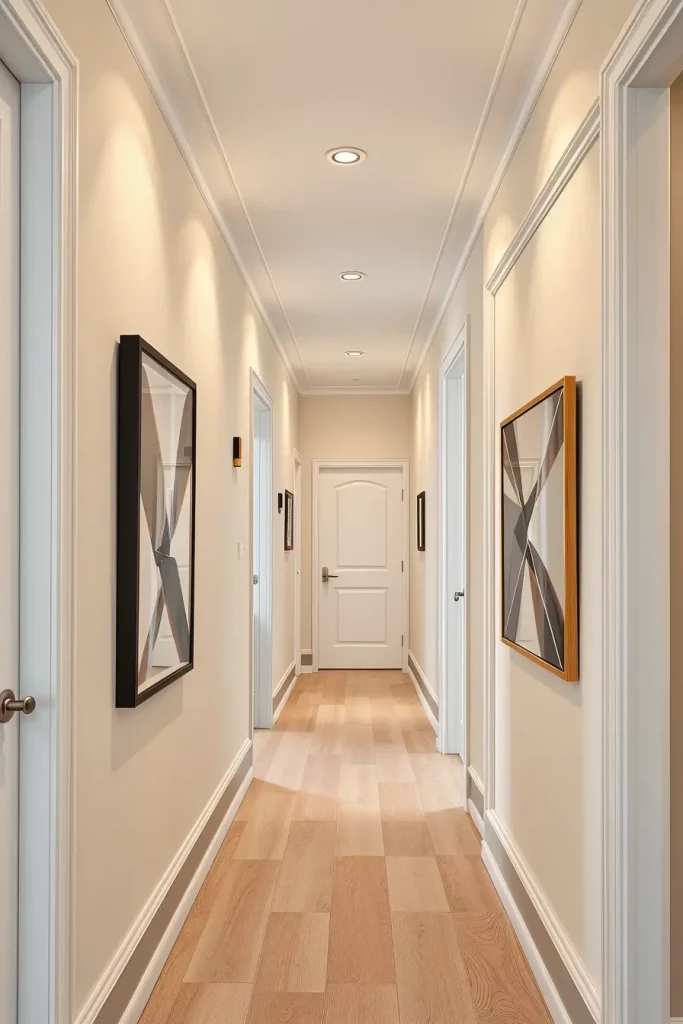
The hallway transformed completely after I applied creamy beige paint to its narrow dimensions. The hallway now appeared twice wider because of the fresh color which also made the artwork stand out even more. The television network HGTV declares that painting small areas with light colors represents an age-old method which continues to deliver outstanding results.
A solution to minimize visual disruptions would be to use matching trim and baseboards. If you want decorative wallpaper that feels airy you should choose light-colored peel-and-stick wallpapers with subtle patterns.
Create a Gallery Wall in a Tight Hallway
A gallery wall stands out as an excellent method to add personal touches to tight hallways while maintaining visual balance. Managed collections of photos and art pieces and travel souvenirs create visual interest which develops an ordinary hallway into a creative design component.

Narrow areas benefit from uniform frames or limited color range usage for their design setup. I organize the design layout on the floor to check for balanced flow before hanging the installation. Equal space between each frame creates a clean and intentional design that should be maintained throughout the gallery wall.
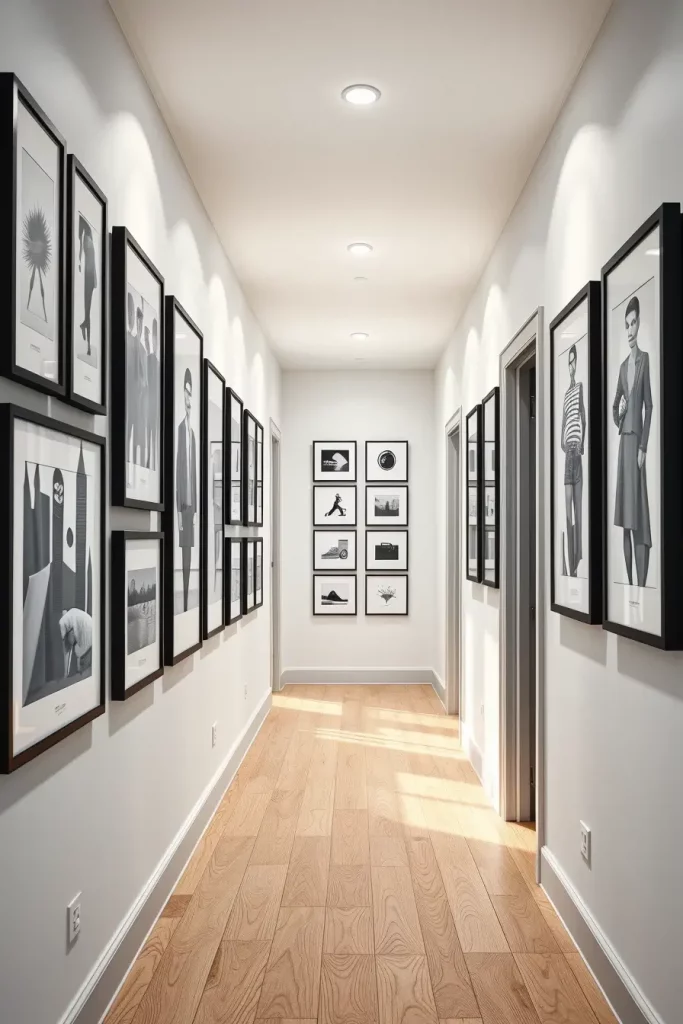
Black and white photo arrangements presented in identical frames create a contemporary gallery appearance according to my experience. Domino Magazine describes gallery walls as home elements that evolve with your style because they function as a “living part of a home.”
The expansion of this concept would include installing small picture lights above each row to enhance both the mood and visual impact of the artwork. A try-and-succeed method would involve arranging your shelves unevenly so you can display both framed artwork and compact items or books.
Choose Narrow Benches With Hidden Storage
Any narrow hallway benefits from the installation of a storage-equipped narrow bench which serves both functional and decorative purposes. My hallway solutions include placing benches near entrances to serve as seats and mask shoes and other items under coat hooks.

Among my preferred designs I like storage solutions that use either drawers underneath or lids that open from the top. For comfort one should opt for upholstered benches yet wood or metal frames deliver a contemporary design. For cover choices faux leather with neutral fabrics prove most appropriate because they provide easy maintenance and upscale appearances.
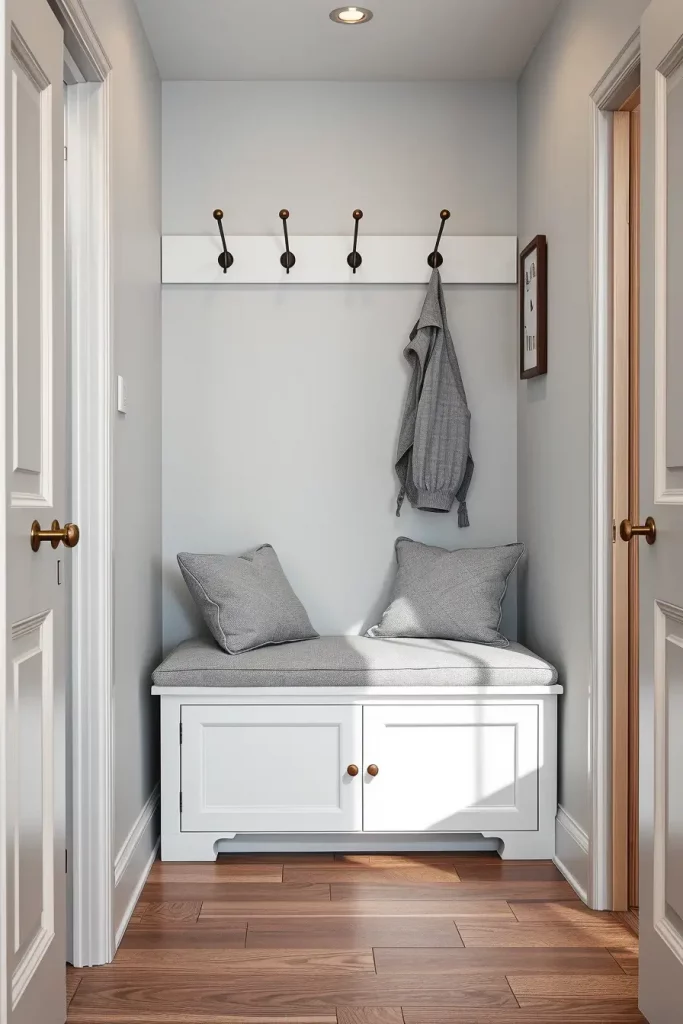
I constructed a custom-made bench for a narrow hallway that measured three feet wide. The 12-inch depth of the bench allowed space for storing 10 pairs of shoes. Martha Stewart Living labels narrow storage benches as “entryway heroes” and I completely support this assessment.
The setup can be made more functional by installing labeled baskets within the storage compartment and a small shelf above the bench for storing scarves and sunglasses during different seasons.
Use Runner Rugs to Draw the Eye Forward
When placed in narrow hallways runner rugs serve two functions by both warming the space while also making it appear longer. I use rugs to both enhance the personality of tight passages and direct the flow of movement through these narrow areas. The rugs establish design cohesion while providing comfort through their ability to finish spaces better than empty floors. These rugs serve two purposes by both absorbing sound and providing excellent performance in busy areas.
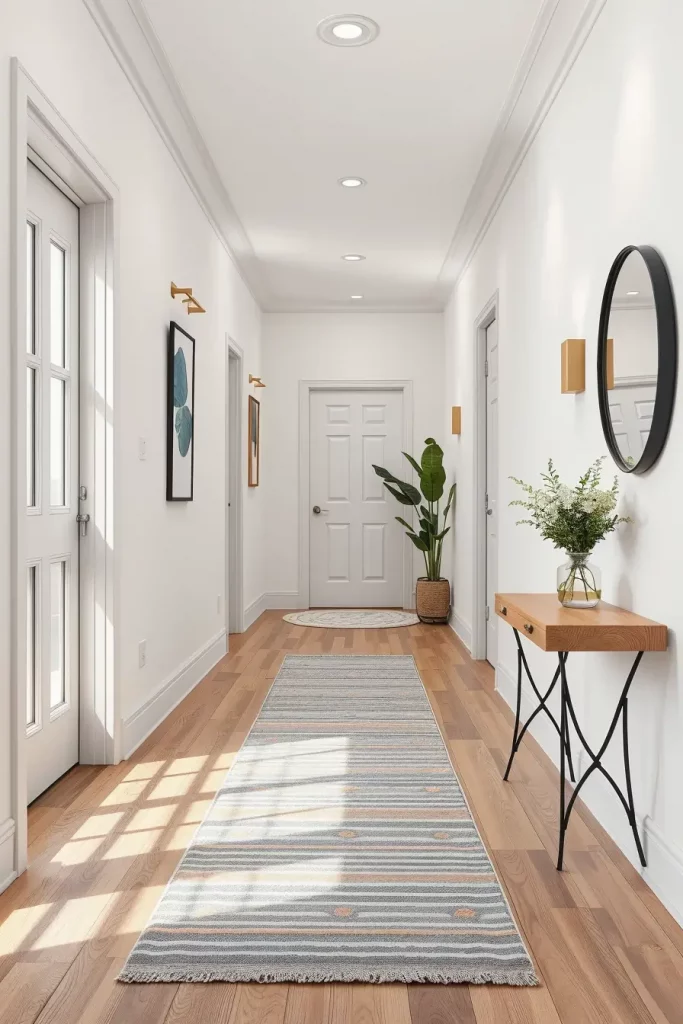
My choice for runners is low-pile construction made from wool blends or synthetic fibers. Select a rug whose color matches both the walls and flooring. The visual effect of a patterned or striped runner leads eyes toward a forward direction which stretches hallway dimensions. Safety requires non-slip backing to be present particularly when many people pass through an area.
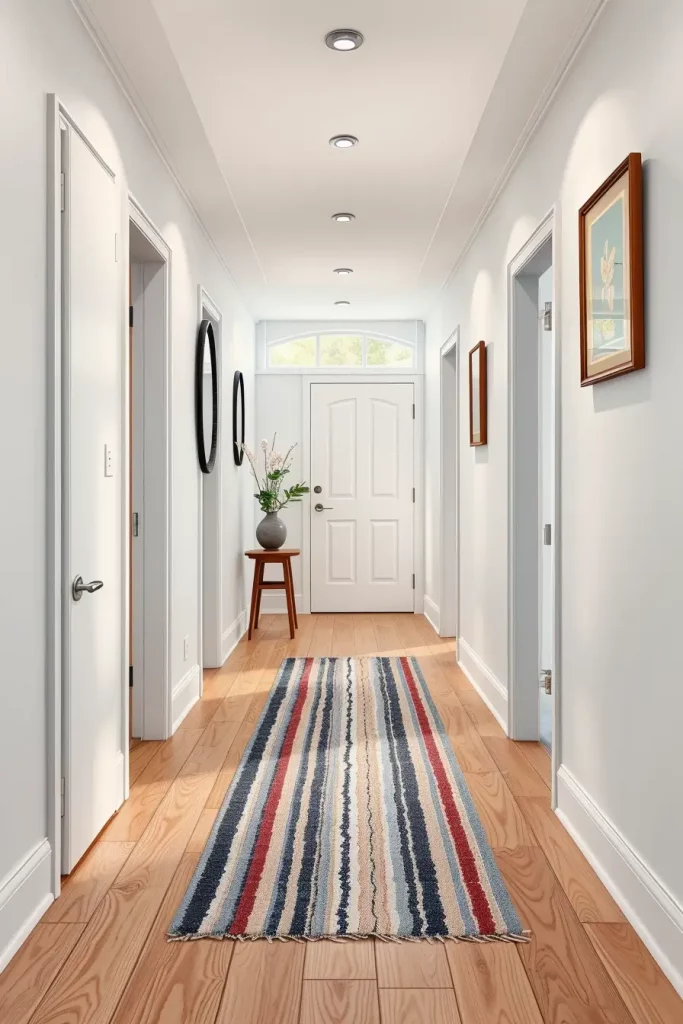
The soft charcoal runner with subtle geometric lines that I selected for my hallway serves as my primary choice. The area received grounding without becoming overpowering. Real Simple supports the use of runners as decorative elements that add texture and color to small spaces where larger decorative items cannot fit. I fully subscribe to this recommendation. The update requires minimal effort while skipping renovation work.
The idea would be improved by placing the runner over hardwood or tile and complementing it with simple wall decor to maintain focus on the flooring.
Add Visual Height With Vertical Wall Stripes
Vertical wall stripes represent an effective method to make narrow hallways appear taller. I have repeatedly employed this visual method in numerous older residences with their low ceiling heights. Vertical stripes in the design direct viewers’ eyes toward the ceiling to create an optical effect of increased height.
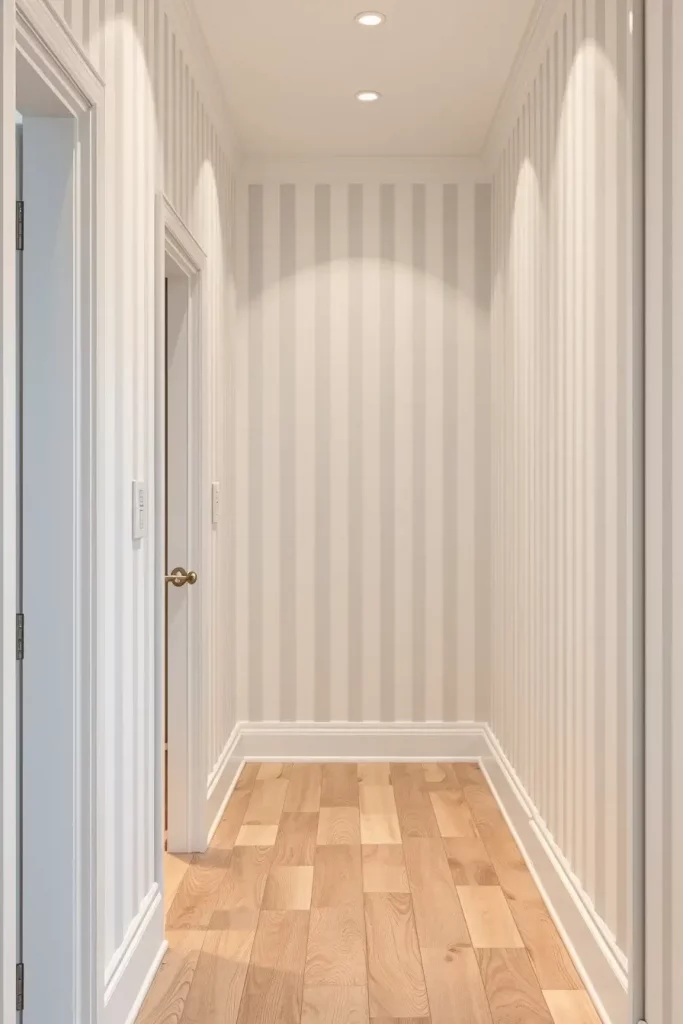
The best choice for vertical stripes includes muted tones that alternate between matte and satin finish for subtle contrast effects. Wallpaper provides precise results for this application but painting can produce equivalent outcomes. A light color scheme should be used to prevent the space from feeling too congested.
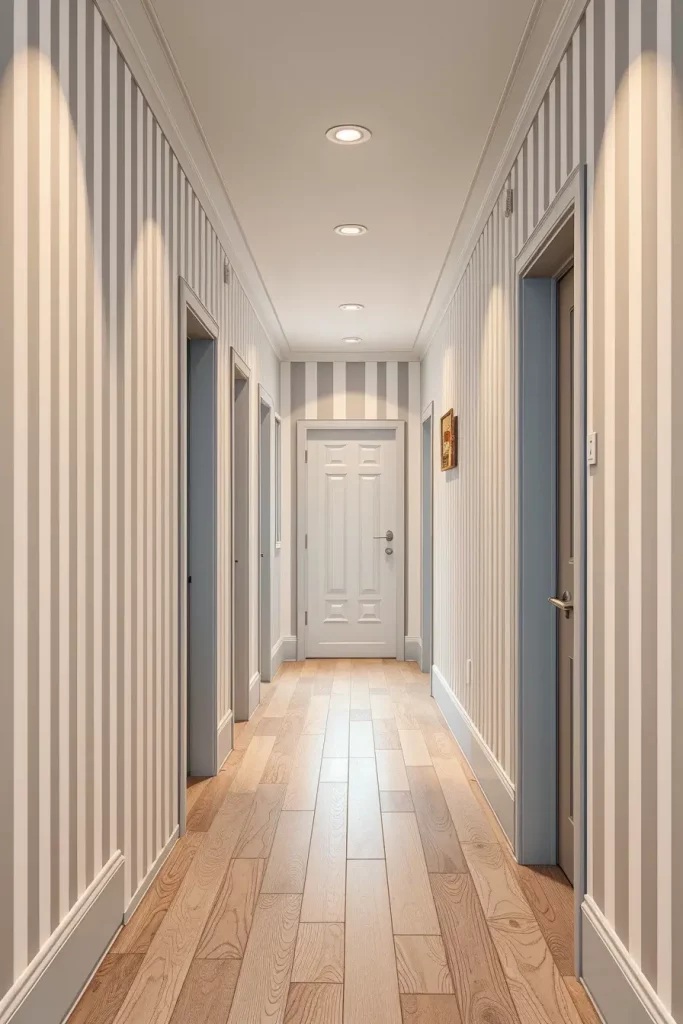
A hallway transformed with pale gray and cream stripes appeared taller according to my personal experience after the decoration project was completed. The pattern brought visual appeal which did not overwhelm the walls. Elle Decor explains that vertical patterns transform the way a room appears taller especially in restricted hallways.
The addition of stripe details on doors or ceiling extension of the pattern would create a contemporary twist according to my suggestion.
Hang Floating Shelves for Functional Decor
The limited availability of floor space in narrow areas makes floating shelves an excellent choice instead of traditional furniture pieces. These pieces serve as versatile object holders that bring storage and design elements to my room transformations in numerous hallway projects without creating a messy appearance. Floating shelves serve as storage solutions because they can display keys along with candles and picture frames and a selection of books.
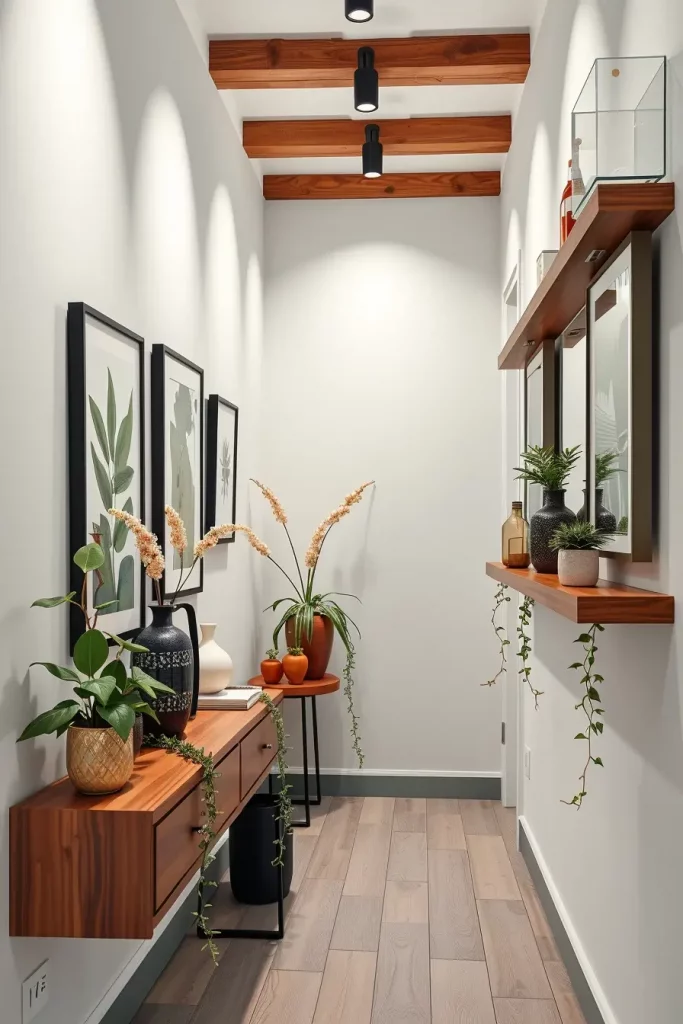
I select wood or matte metal floating shelves which do not exceed 6–8 inches in depth. Place the shelves at the center wall position or arrange them in vertical rows for an artistic display. The placement of corner-mounted floating shelves works best to enhance L-shaped hallways and entry door areas.
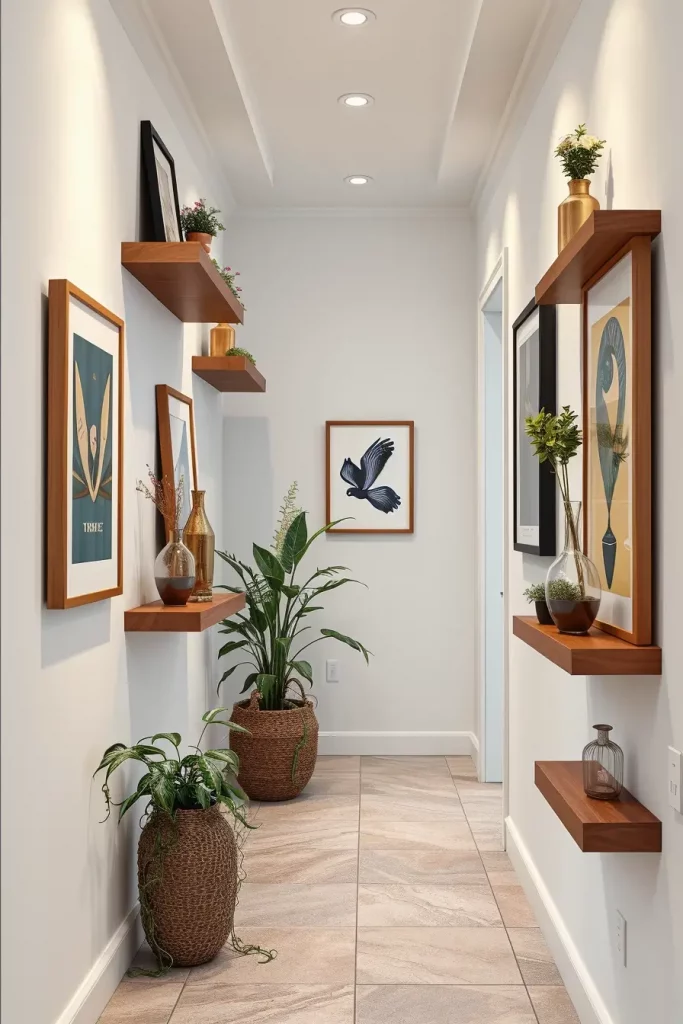
I arranged floating oak shelves by placing framed mini artworks and a ceramic pot with trailing plant on them. The hallway gained an energetic and stylish appearance that avoided excessive fussiness. According to Apartment Therapy the method enables passageways to get the most storage space while looking visually appealing.
The final touch for this setup should include under-shelf illumination or wall brackets made from the same material as the shelves to achieve a cohesive appearance.
Style With Sconces or Slim Wall Lights
Narrow hallway lighting gets transformed powerfully by wall sconces since these fixtures serve both decorative and functional purposes. Wall sconces replace overhead lights allowing the space to avoid darkness while establishing positive emotions within the hallway.

I select sconces with minimal profiles which produce either upward or downward illumination. The appropriate finishes for wall sconces or slim wall lights include brass and matte black and brushed nickel depending on hallway color schemes. To achieve a contemporary appearance I select wall-mounted LED sconces that disappear into the wall surface. The sconces provide smooth lighting throughout the area and they serve to maximize space allocation.
I designed a project where matte black sconces illuminated white walls and a dark wood runner creating an elegant and simple appearance. According to Lighting Design & Application Magazine wall sconces provide better illumination of narrow spaces than ceiling fixtures when positioned properly throughout the hallway.
Dimmable features would provide enhanced sophistication because they enable users to control light intensity according to daily times and events.
Create an Accent Wall With Bold Wallpaper
A narrow hallway gains bold character through the use of accent wallpaper as one of the most impactful design choices. I choose to decorate one hallway wall usually the last one with a strong pattern or textural design. The wall treatment captures attention while introducing character elements that do not dominate the entire hallway area.
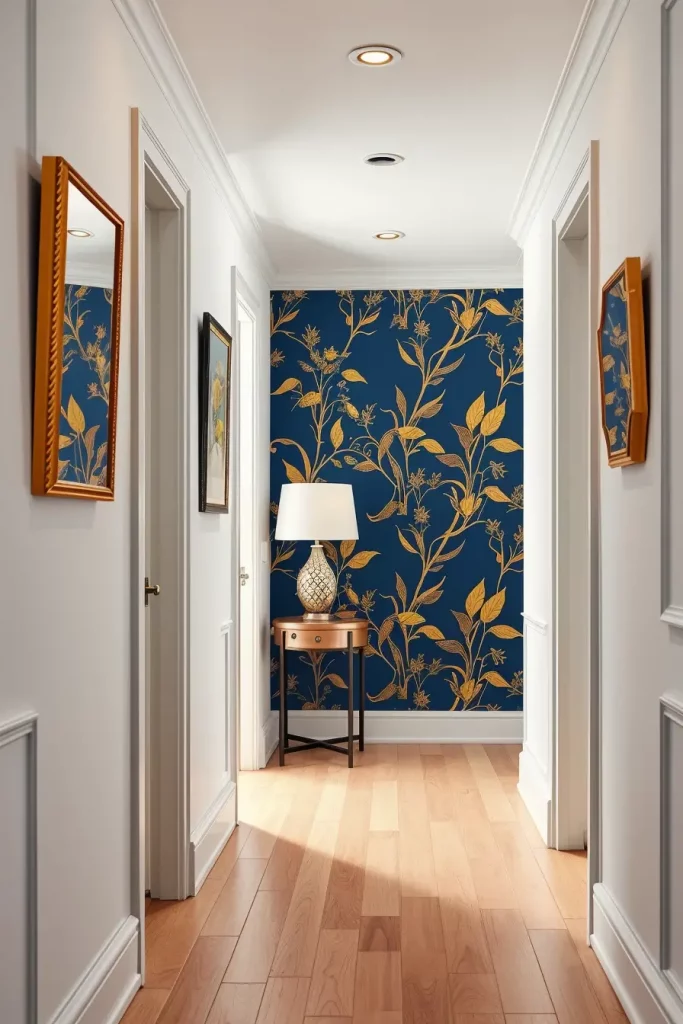
For renters who want to change their walls select removable wallpaper but homeowners can use grasscloth or geometric prints. Small amounts of high-contrast patterns together with metallic designs make my preferred choice. Using this technique produces an effective result when walls surrounding the statement are neutral.
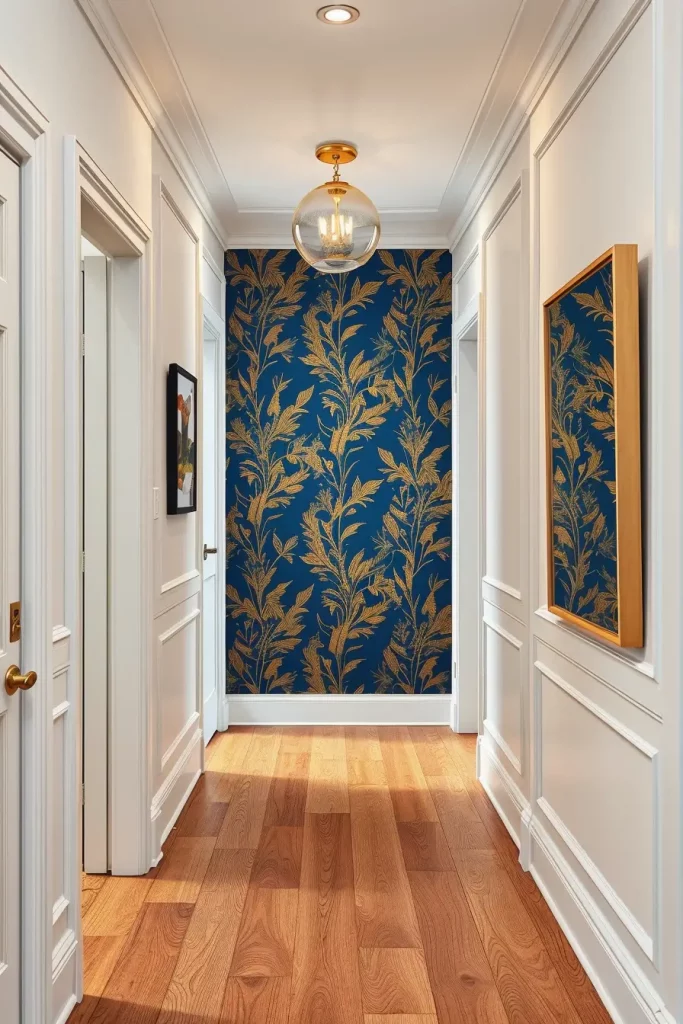
A short hallway receives striking visual appeal through navy-and-gold Art Deco-inspired wallpaper on its end wall which guests always discuss. House & Garden suggests that wallpaper should be used to create memorable transitions in hallways according to this design principle.
You can enhance the appearance by applying molding around the wallpapered area and by incorporating lighting to showcase both texture and metallic components in the pattern.
Use Transparent Furniture to Avoid Clutter
Narrow hallways that need furniture yet have minimal space require transparent materials such as acrylic and glass to serve as essential tools. The solution of clear console tables combined with Lucite stools in narrow corridors provides functional surface space that avoids visual distractions.
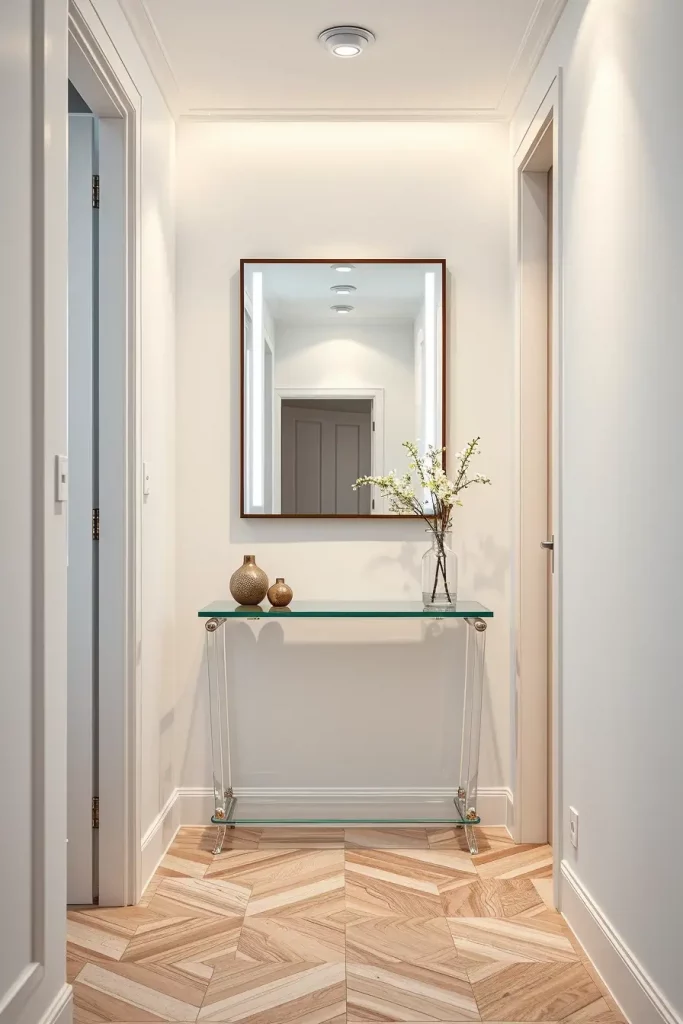
The clear acrylic console both serves a purpose and remains practically invisible to the eye. The transparent furniture serves as a keyholder and decoration stand while maintaining an open hallway appearance. Display boxes attached to walls with transparent materials serve as great art and collectible showcases while maintaining an unweighing appearance.
I applied a glass console table next to mirrored walls under soft illumination in my recent design work. The design exhibited a clean atmosphere combined with freshness and elegance. Veranda magazine selects Lucite and glass pieces for small interiors because these materials enable light transmission and minimize physical bulk.
To create a personalized effect with transparent items pair them with soft materials such as fabric-covered ottomans and ceramic decorations to soften the sleek appearance.
Install Peg Rails for Hanging Items
Narrow hallways benefit from the classic storage solution that peg rails provide. Peg rails serve as practical storage solutions when I install them on one wall for holding coats and bags and hats in homes that lack entryways or have minimal entry spaces.

I choose wooden peg rails that receive wall color treatment for matching appearance or different colored paint coats for creating farmhouse style. A proper spacing of pegs at 4 to 6 inches distance creates functionality without creating overcrowding. Certain rails include additional upper surfaces that function as storage space for decorative items.
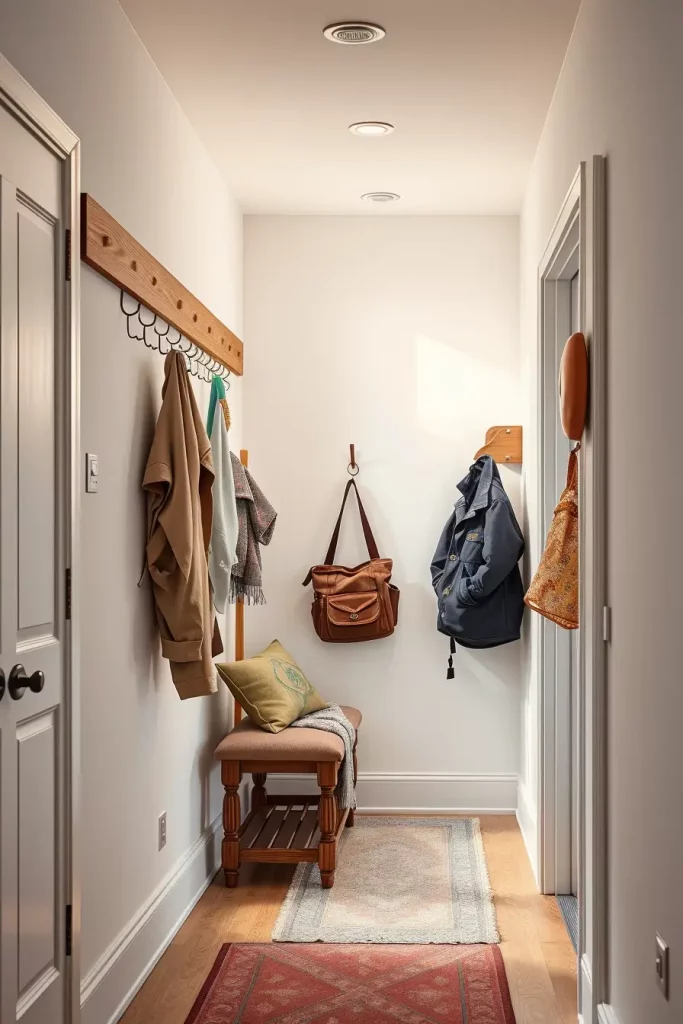
I installed a white oak peg rail along with brushed hooks which rested above a narrow bench during a hallway transformation. It looked intentional and elegant. Peg rails serve as an excellent solution for vertical space management because The Spruce describes them as “ideal for maximizing vertical space while keeping the floor clear and functional.”
The functionality of this solution can be enhanced through the addition of a narrow shelf positioned above the rail or by combining it with a chalkboard or corkboard for note storage.
Add Greenery With Narrow Wall Planters
Vertical design elements through wall planters serve as my preferred recommendation for narrow hallways. Wall planters serve as an effective solution to introduce indoor nature without taking up valuable floor space. The decorative wall planters bring fresh elements to the corridor by blending hard surfaces with natural elements and creating visual appeal on plain walls. Planters mounted on walls create an upward visual effect that enhances both space elevation and openness.
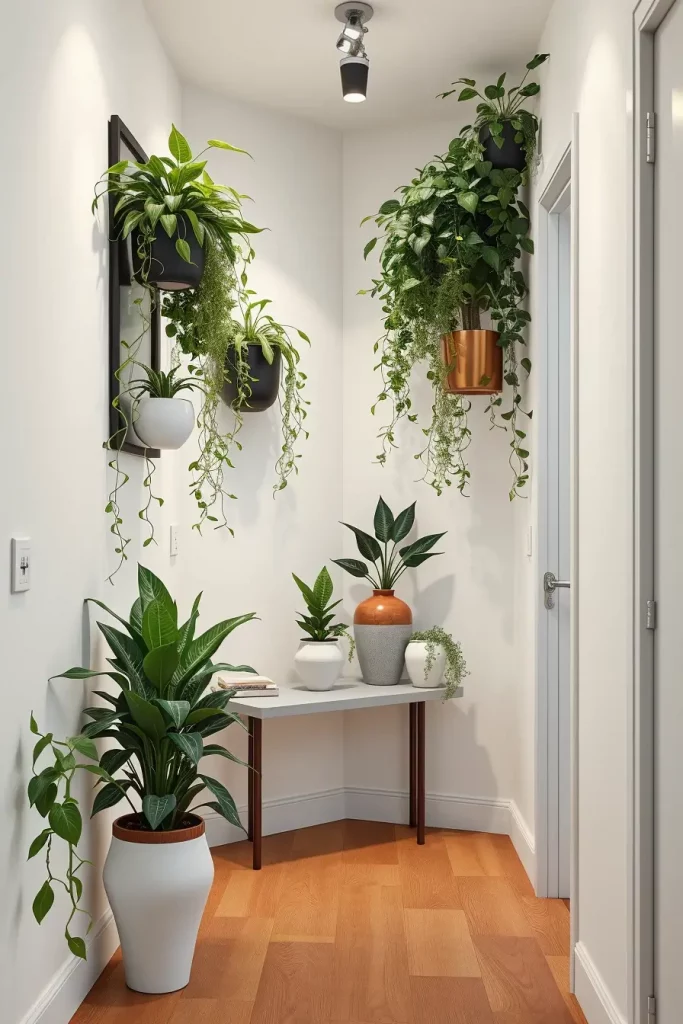
My preferred planters consist of minimalist metal or ceramic designs which can be arranged either in vertical stacks or staggered configurations. The best choice for vertical planters includes pothos and ferns to create an organic flowing appearance. White lacquered wooden backboards with their structure and contrast provide support for your greenery. The proper lighting of your plants is essential because spotlights either above or below them will make them stand out while illuminating the hallway. Small spaces benefit from this plant solution when the selected plants need minimal care and do not require sunlight for growth.
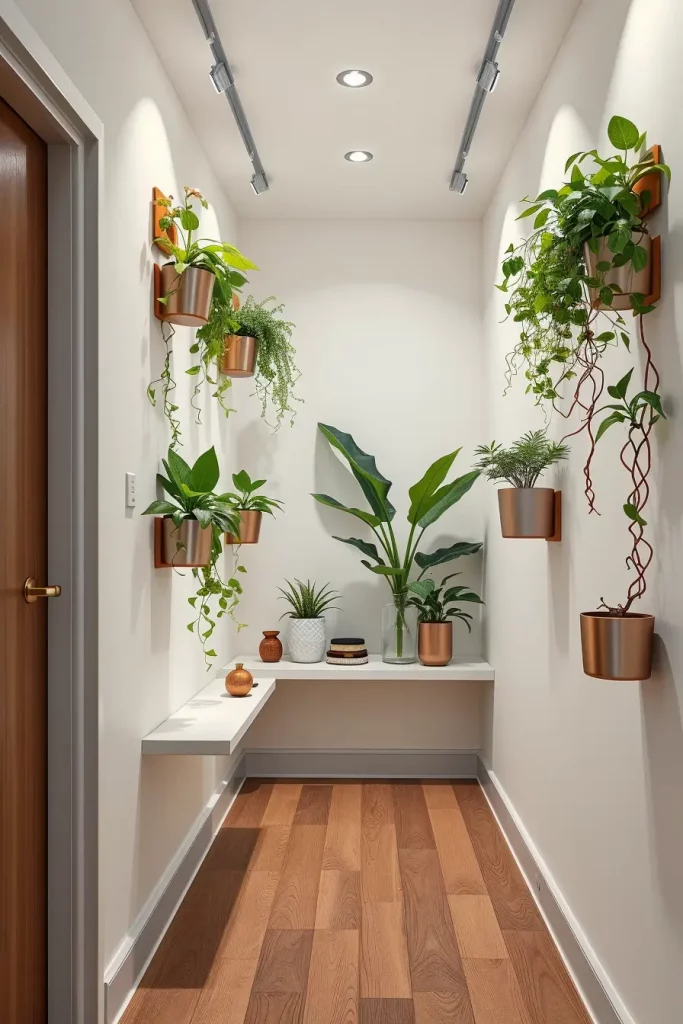
I have witnessed numerous occasions in which this approach transformed boring entryways into fascinating transit areas. The article from Architectural Digest recommends combining real plants with artificial greenery to achieve the design effect without ongoing maintenance requirements. The small green accents bring both positive mood effects and better air quality which my clients strongly appreciate.
A narrow floating shelf or slim console table placed beneath the planters would serve as an ideal spot for key storage or candle display or holding a small tray. The addition of this element serves to finish the design while providing practical benefits.
Mix Art and Mirrors for an Eclectic Look
The combination of framed artwork with mirrors serves as an effective method to introduce both character and practicality to narrow hallway decorations. A combination of mirrors which reflect light to create depth and artwork which delivers color alongside emotional and textural elements produces this aesthetic. This particular blend serves homeowners seeking an artful touch without stuffing an enclosed space.
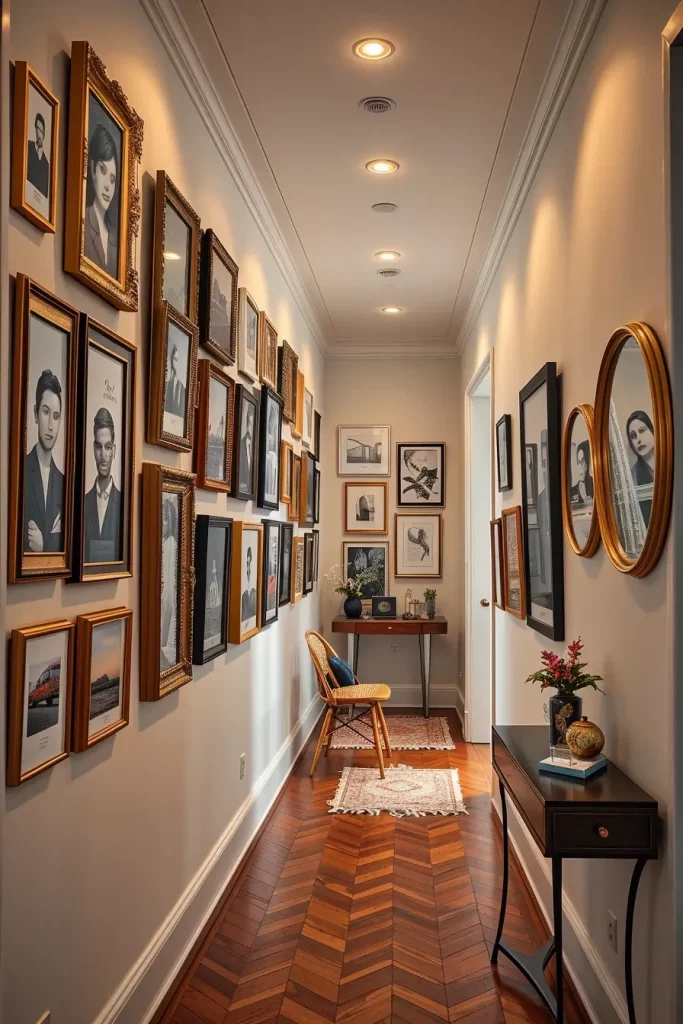
The space can be decorated by alternating between small to medium-sized contemporary prints and family portraits and abstract artwork with either frameless or lightly framed mirrors. The arrangement depends on ceiling height as I either place them in a straight horizontal line or use a gallery wall structure. The selection of decorations should unite through similar color patterns for continuity while maintaining energetic design elements.
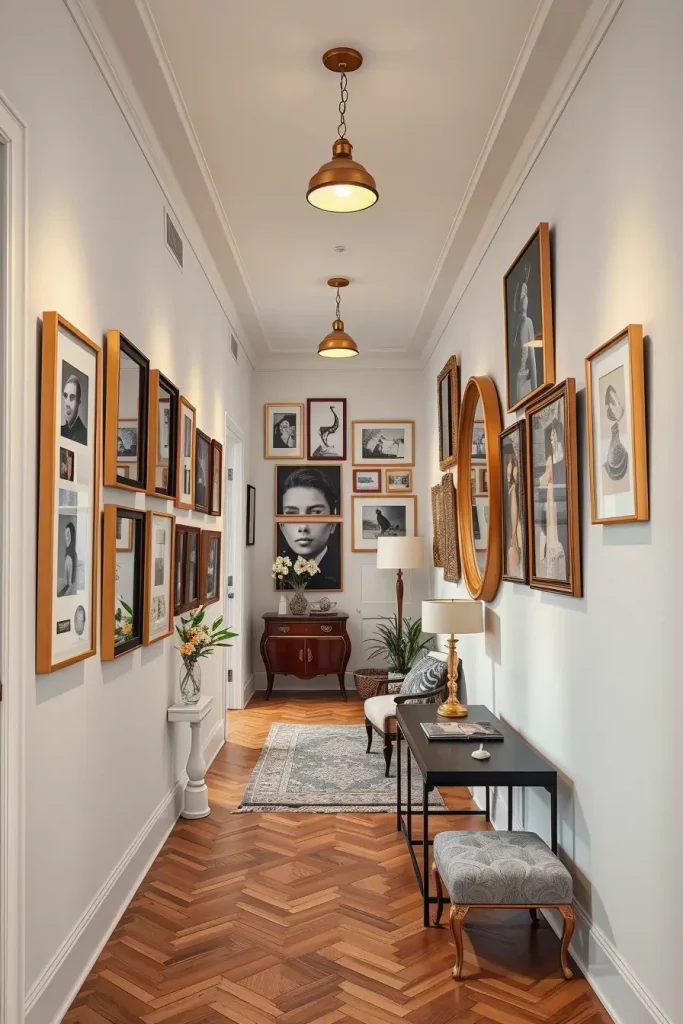
Black-and-white photographs paired with antique gold-rimmed mirrors create both elegant contrast in my opinion. Nate Berkus the interior designer advocates for adding layered meaning to gallery walls because it transforms hallway spaces into authentic and cared-for areas. The combination of matte black frames with round convex mirrors creates an ideal effect in transitional homes.
My recommendation for enhancing this concept involves installing either a narrow picture light or a plug-in sconce to better showcase the artwork. The combination of elevated presentation with ambient lighting results from this addition.
Incorporate Arched Mirrors for Architectural Charm
Arched mirrors stand out as my preferred method to achieve architectural appeal through non-invasive means. The curved shape of arched mirrors automatically enhances narrow hallways while giving them a romantic European character. Placing arched mirrors at doorways or hallway ends generates depth and mirrors both light and color reflections.
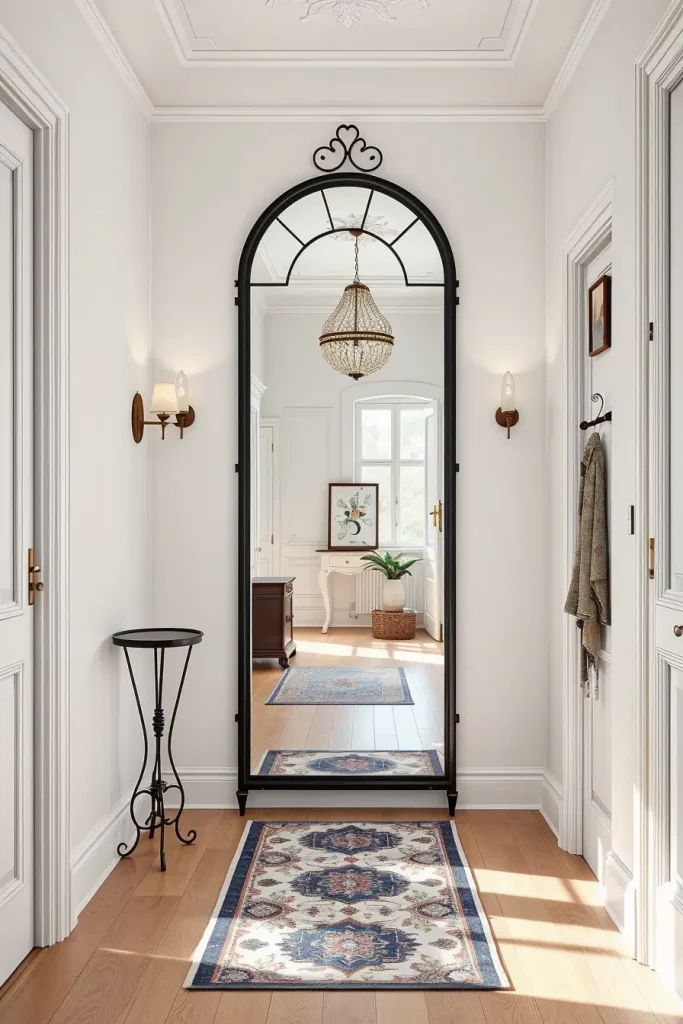
A single arched mirror extending from floor to ceiling should be your choice when selecting this element. The frame can be made from wood, brass or black iron. The focal point status of this mirror extends hallway perception while providing brightness throughout the space. Narrow walls become sophisticated with multiple slimmer arched mirrors arranged in rows. The combination of light-colored walls and wall sconces helps boost the reflective power of arched mirrors.
The combination of contemporary minimalism with classic elegance makes arched mirrors highly popular among clients according to my experience. Architectural interest in narrow entryways or corridors receives enhancement through arched mirrors which appear frequently in Elle Decor and other top design magazines.
My additional design touch would include a vintage runner rug along with a minimal vertical coat rack or sculptural stand. The design perfectly unites practicality with aesthetics.
Use Reflective Surfaces to Brighten Up the Hall
To illuminate dark narrow hallways I use reflective materials as my solution. The application of glossy paint together with glass and mirrored panels and metallic finishes creates an effect that distributes light throughout the space. The purpose of this design works best in homes that have interior or enclosed corridors.
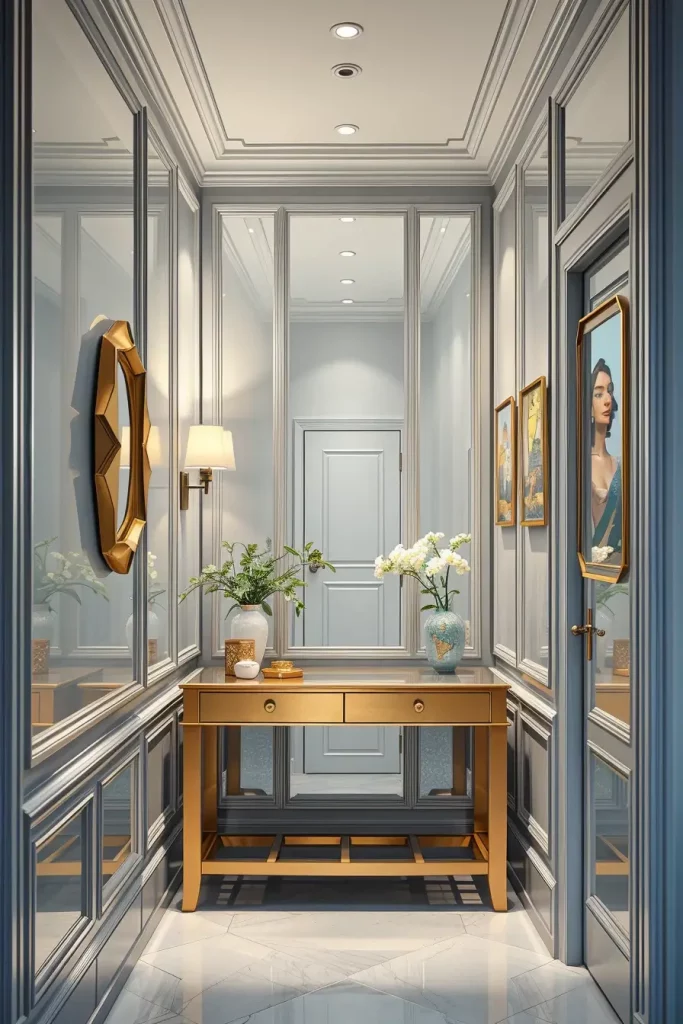
You should either build a mirror-paneled accent wall or paint with high-gloss neutrals including pearl gray, sand or pale blue. The shine and depth of spaces increase when console tables and decorative wall panels receive metallic finishes in brushed gold or silver. The space benefits from reflective photo frames together with lacquered storage units.
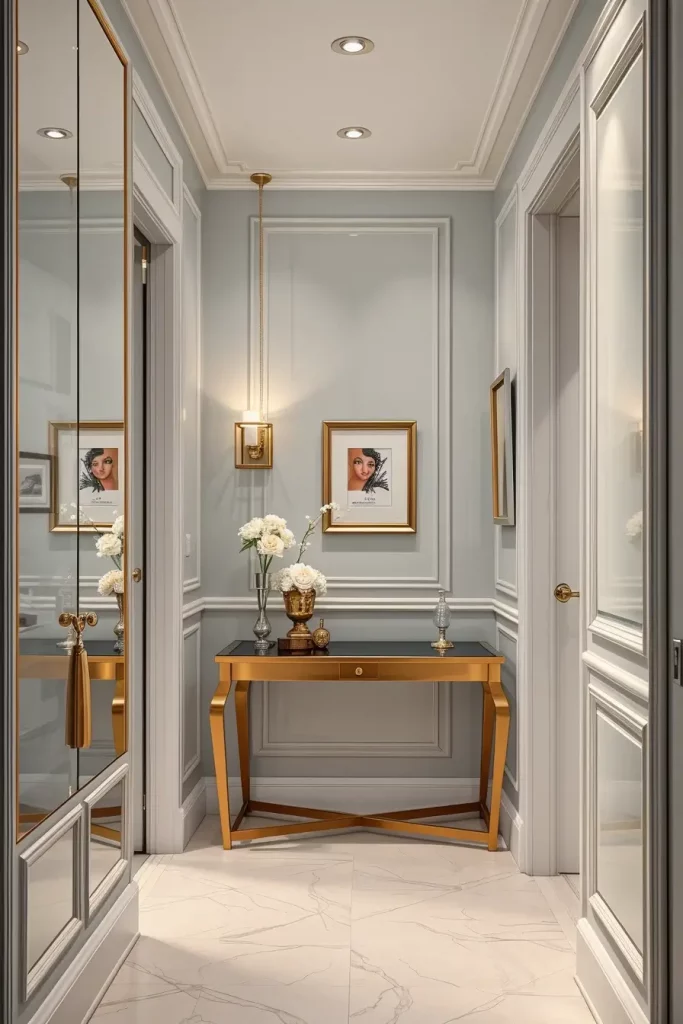
This approach succeeded when I applied it to an apartment hallway without windows. The article from House Beautiful explains reflectivity serves as an approved designer method to create artificial sunlight and increase interior brightness. Excessive shiny elements should be avoided because they create a cold and sterile environment.
A light-diffusing ceiling fixture combined with a patterned runner having subtle metallic threads will provide this space with additional texture and shimmer for an elevated appearance.
Choose Low-Profile Seating for Comfort and Space
Narrow hallway decorations should include seating because it delivers significant added value to the space. For my designs of such spaces I opt for furniture with low height but includes plenty of comfort to serve as seating areas while still enabling free movement. The combination between an easy-access seat and an ottoman doubles up as both practical storage and visual decoration for hallways.

Slender benches made from linen or leather or velvet serve as my preferred choice because they feature concealed storage underneath. Wall-mounted flip-down seats function perfectly well in spaces with extremely narrow corridors. A combination of a small side table and books creates a layered welcoming appearance when placed next to these items. A cushion or throw placed on available space will create visual texture.
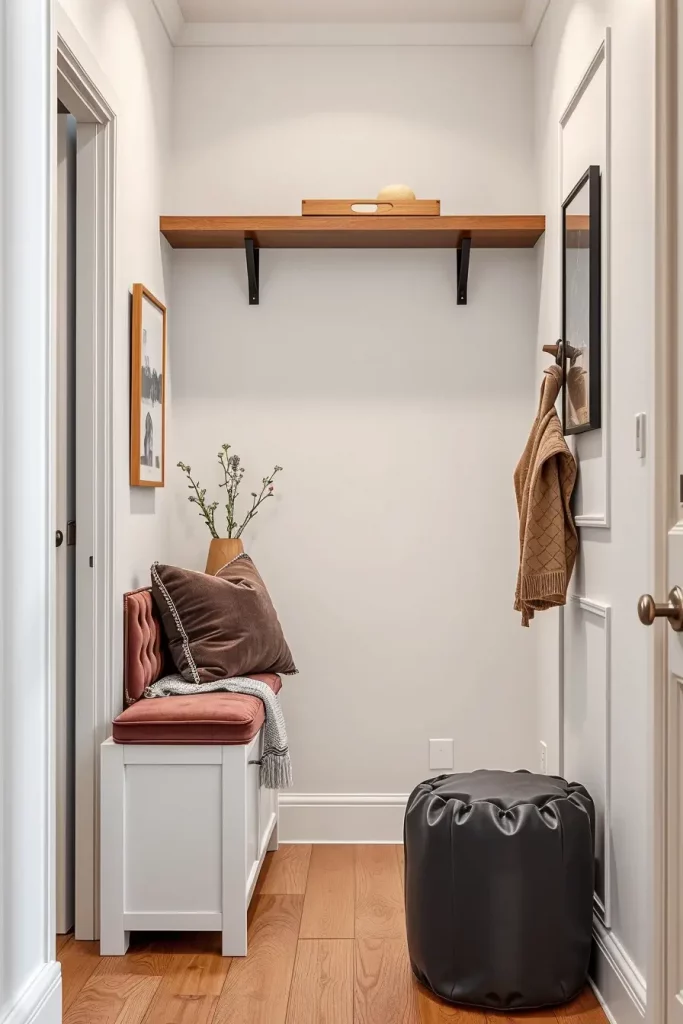
The addition of hallway seating has become popular among clients because they use it for shoe removal and grocery resting and visual breaks. The article from Better Homes & Gardens states that hallway seating creates a welcoming atmosphere which makes small spaces feel more comfortable.
A coat rack or floating shelf above the bench would serve as both storage solution and finishing element for the zone.
Add Statement Ceiling Fixtures to Draw the Eye Up
The most intelligent method to improve narrow hallways involves directing attention toward the ceiling. Statement ceiling fixtures work effectively for this purpose because they serve to redirect visual attention from confined walls toward elegant lighting design. The design works best when hallways reach heights above standard ceiling height.
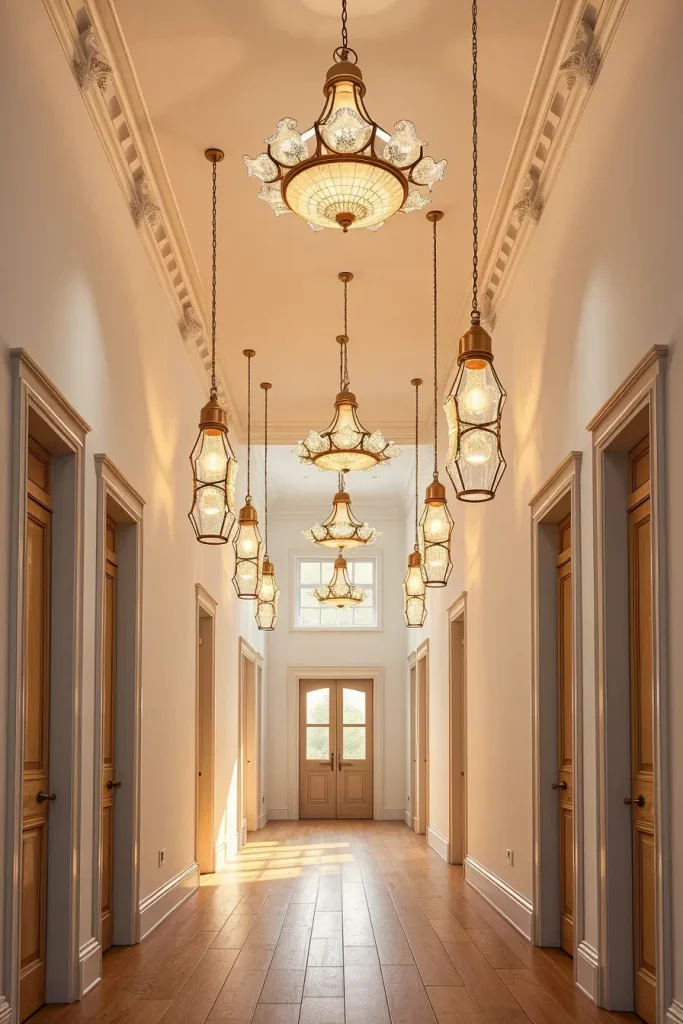
The lighting fixtures I prefer consist of sculptural pendants and mini chandeliers together with sleek flush mounts. Select frosted glass and aged brass or matte black materials which will match the existing hallway color scheme. The height of the fixture should be appropriate to prevent any obstruction during movement.
My strategy of installing globe pendants in series has proven successful for creating a visually appealing effect on long hallways. HGTV refers to lighting experts who recommend using ceiling visual rhythm patterns as a way to generate dramatic effects and enhance spatial perception. Statement fixtures bring enough illumination while simultaneously serving functional and decorative requirements.
To enhance the day-time illumination I would string wall sconces together with recessed lights that could be controlled through a dimmer for multiple ambience levels.
Install Recessed Lighting for a Clean Look
Small halls should use recessed lighting due to its capability to distribute uniform illumination across the space without causing visual disruptions. The application of this lighting method works best in tight spaces or minimalist-style rooms.
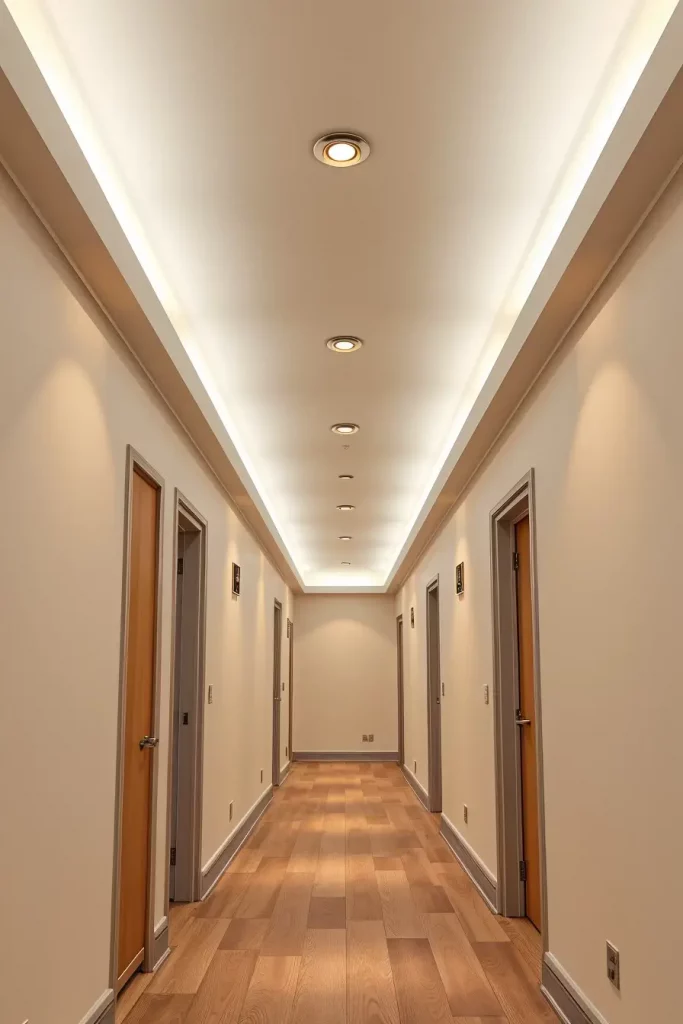
The standard layout I use involves installing LED downlights at regular intervals across the ceiling. The lights complement dimensional features by working together with wall washers as well as directional illumination to illuminate artworks or decorations. Warm white light fixtures paired with automatic lighting controllers enable you to determine illumination levels.
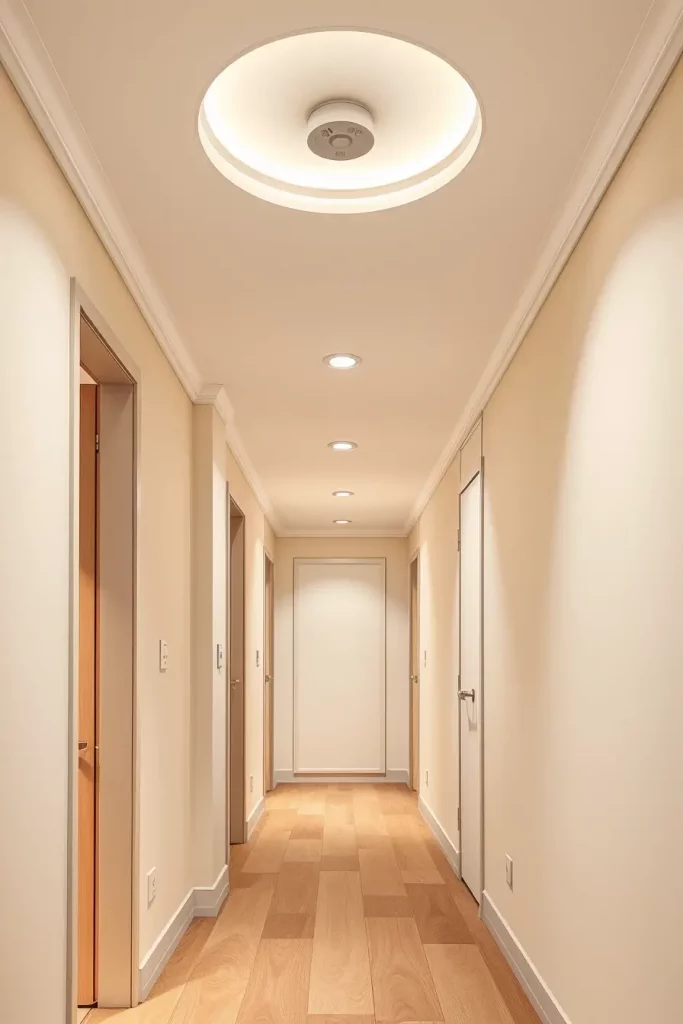
The uncluttered design I use for contemporary hallways represents my trademark approach. Apartment Therapy states that well-planned recessed lighting creates a space that feels wider and more welcoming through its ability to eliminate shadows. The lighting configuration works perfectly for residential and office spaces.
To improve this design I suggest either painting the ceiling with a reflective light color or adding a soft-textured runner to create a warmer ambiance.
Layer Lighting With Wall-Mounted Task Lamps
To light up narrow hallways I always propose multiple layer installation for producing depth along with interest. The wall-mounted task lamp serves as an excellent lighting solution which provides both practical benefits and decorative appeal. These fixtures illuminate artwork while lighting the path during darkness and they generate warmth in spaces that lack illumination.
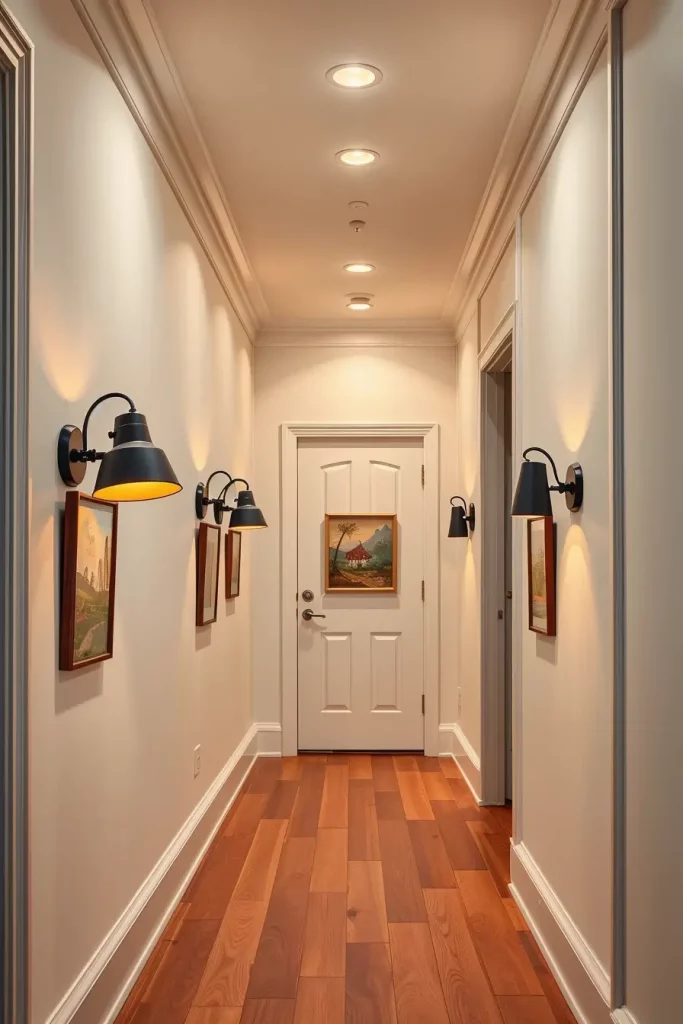
The hallway receives wall-mounted slim adjustable sconces and articulating arm lamps which I position at eye level throughout the space. The fixtures should be positioned above artwork or near seating areas to generate small illuminated areas. The hallway decor determines which finish works best between matte black, brass or brushed nickel. The installation of ceiling illumination and natural illumination will create a balanced welcoming environment.
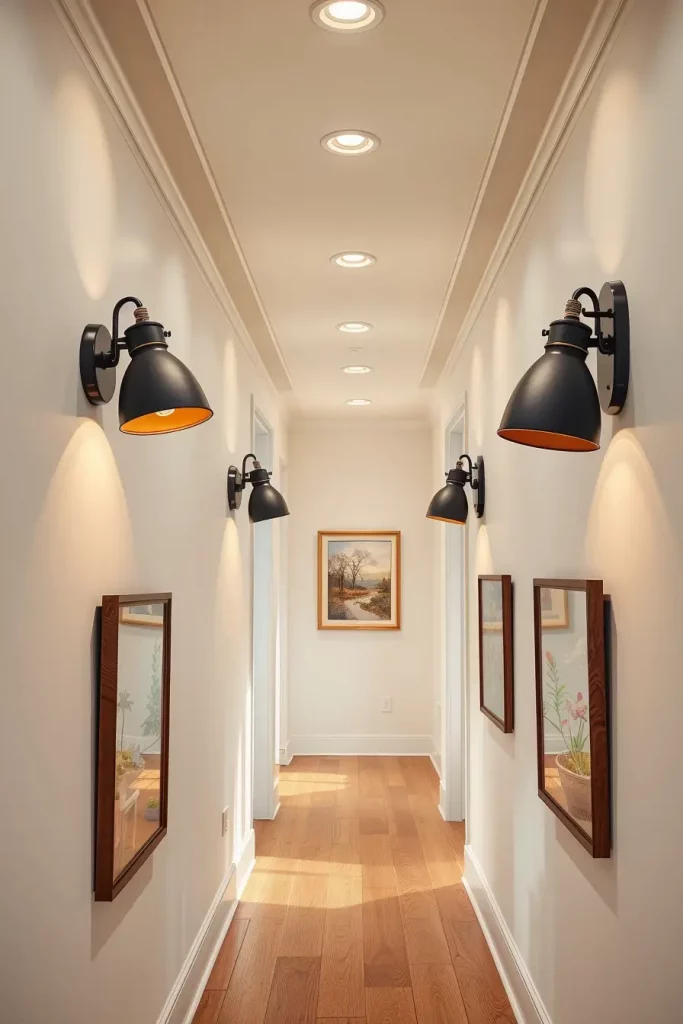
Based on my observations such added lighting elements make long hallways more interesting so visitors naturally want to spend time there. The publication House & Garden promotes task lighting as an effective method to “paint with light” throughout transitional areas which I endorse completely. The design control system through this method lets you choose which elements to highlight.
The section can be finished by using smart bulbs which offer dimming and color control features. The ability to switch light temperatures between warm evening and cool daytime conditions becomes possible through this feature.
Use Paint to Define Zones in Long Hallways
The strategic application of paint enables creative division of monotonous long narrow spaces. The technique creates both visual personality and rhythmic structure in addition to improving spatial organization. I split spaces without walls by applying various paint shades and distinctive wall finishes.
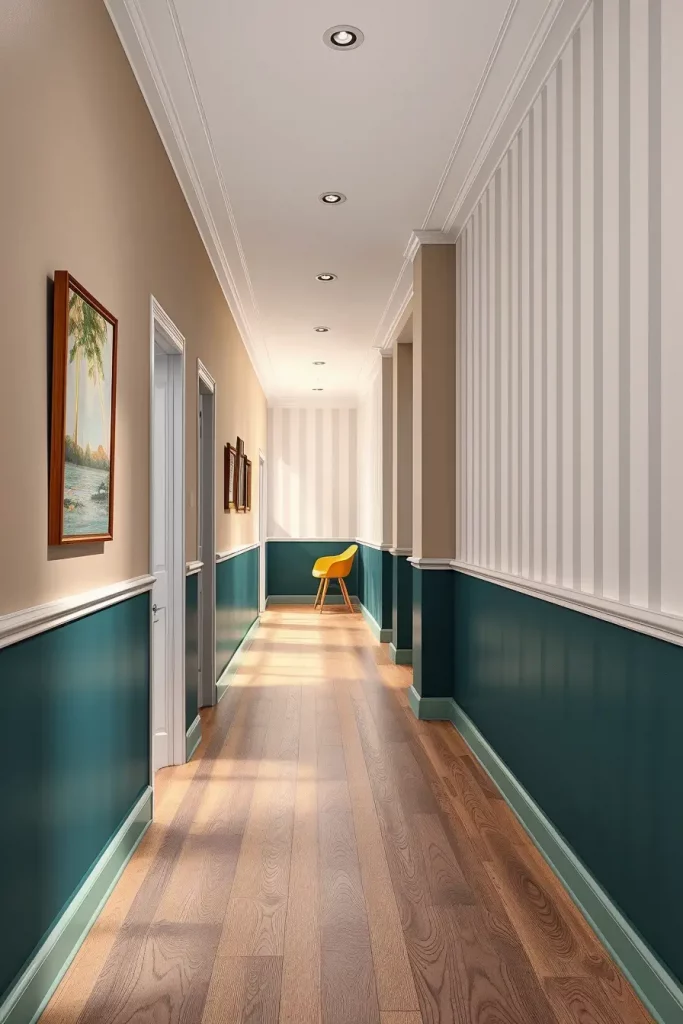
The bottom section of walls should receive a deep paint color such as slate, navy or forest green while maintaining a lighter tone for the upper section to achieve a grounded yet airy appearance. You can develop rhythm through vertical or horizontal striped paint designs or create an artistic ombré appearance. Chalkboard paint functions as both decorative and functional paint especially when used in family-oriented homes.
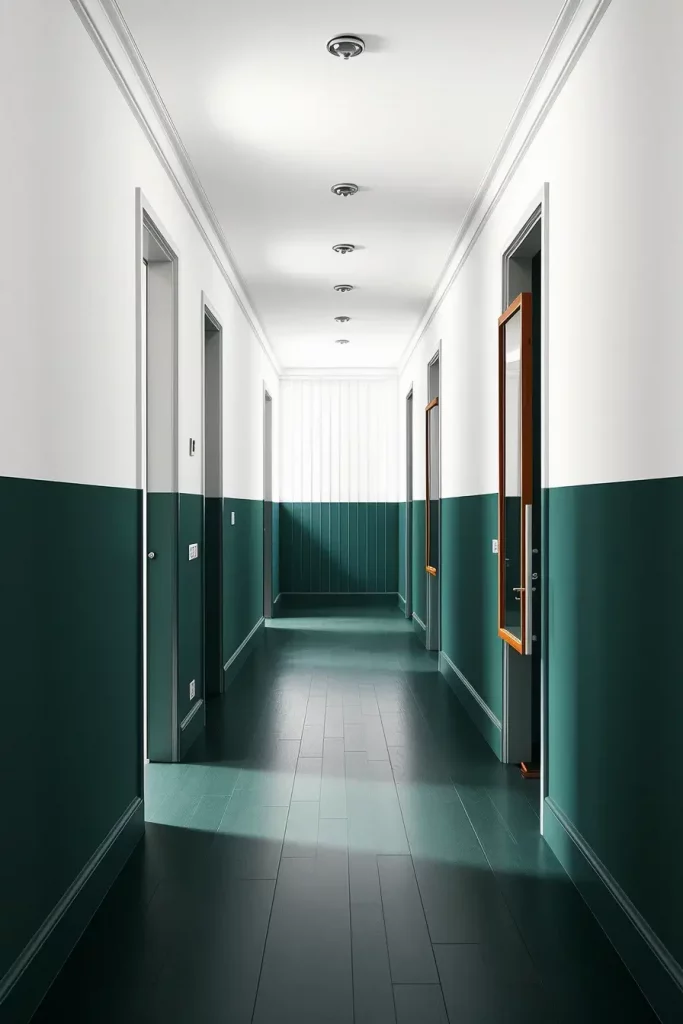
When implemented this method produces significant changes in extended corridors. The technique stands as one of my top affordable design solutions. Real Simple explains that dividing spaces with color makes the eye believe different functional areas exist thus enhancing the perception of roominess in confined spaces.
To create additional definition I recommend installing thin chair rails or moulding strips at the color boundary points. The effect becomes stronger alongside the creation of valuable architectural elements.
Hang Curtains to Soften Long Narrow Walls
Creative curtain placement transforms narrow hallway decorations into polished and soft decorative elements. To add warmth and dramatic effect in areas with cold corridors I introduce draped fabric as a softening element. Curtains function as transition markers between spaces as well as effective concealment tools for unappealing doorways and panels.
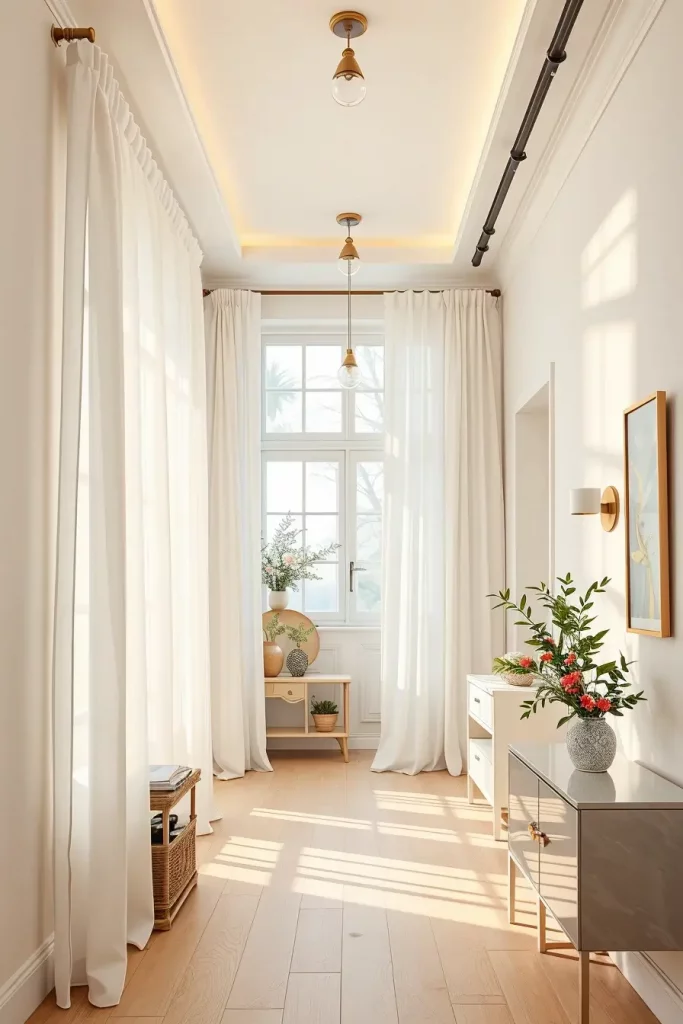
I choose ceiling tracks for curtain installation then use lightweight linen or sheer or velvet drapes to achieve a flowing effect. Choosing neutral color palettes will produce a tranquil effect but deep teal together with mustard create an appearance of luxurious depth. The gathering of curtains depends on your desired ambiance whether you prefer a gathered or loose appearance.
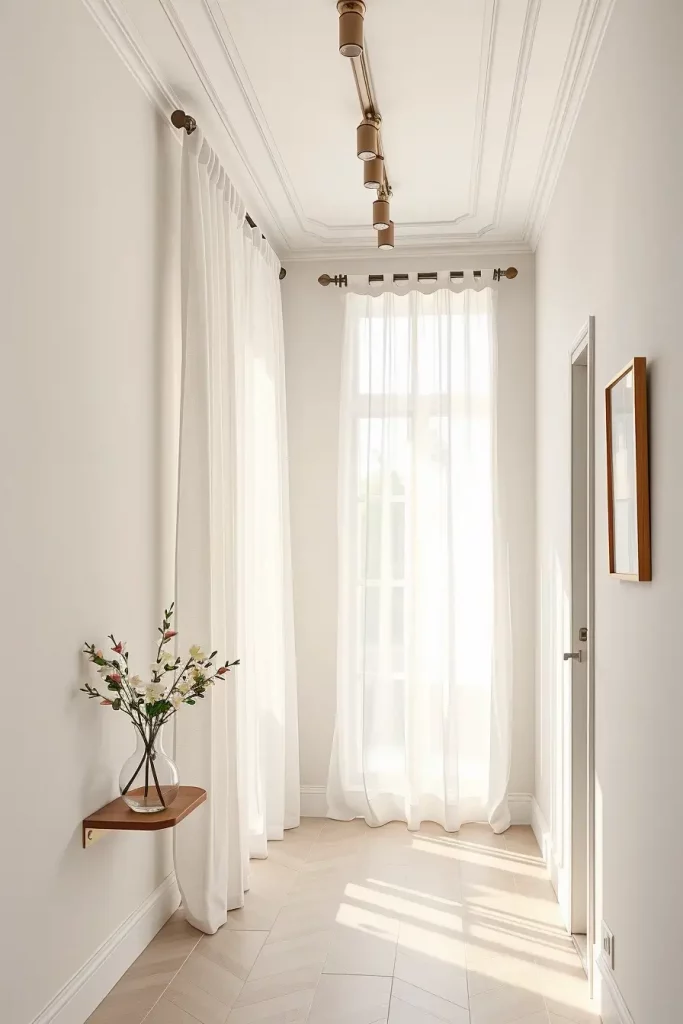
The technique proves most beneficial for rental properties along with homes that do not possess architectural details. This technique provides a fast method to achieve both comfort and visual depth in a space. Hallway curtains have emerged as a new design trend according to The Spruce which helps rooms transition smoothly.
The concept can be made stronger by using uplighting or track lighting above the drapery line together with these curtains. The fabric acquires a gallery-like appearance because of this treatment.
Incorporate Hidden Storage Behind Wall Panels
Narrow hallways normally lack proper storage solutions even though storage needs are high in these tight spaces. The best solution for space optimization involves building storage areas within wall panels. Hidden storage behind wall panels serves as an excellent solution to store seasonal items and cleaning tools and everyday essentials without affecting corridor visibility.
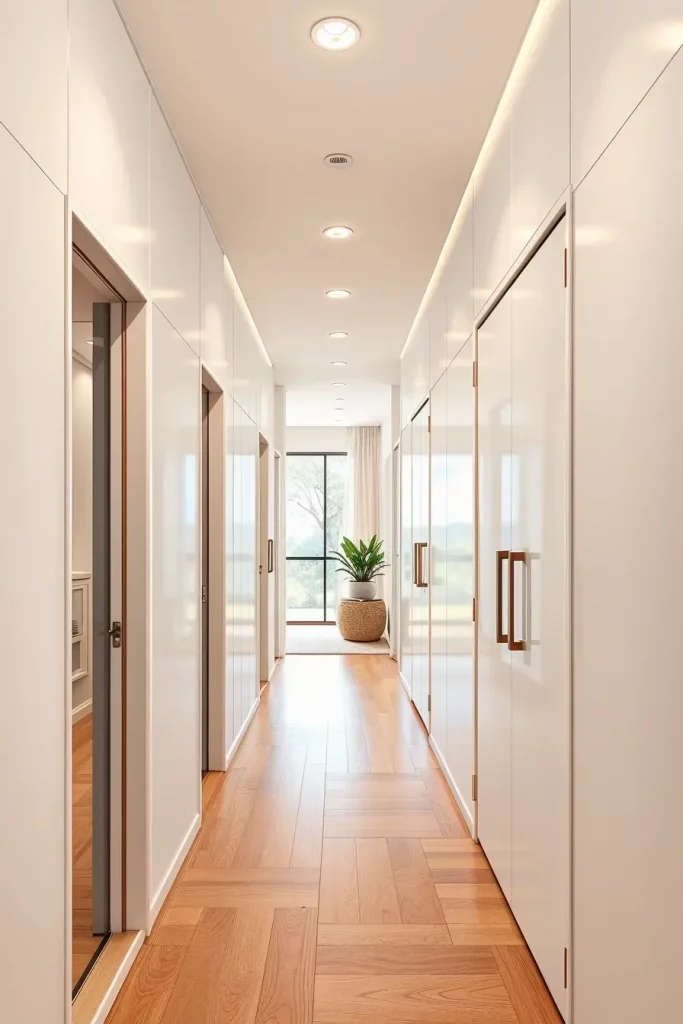
I create wooden or laminate panels that use touch-latch hardware to enable smooth and flush opening operations. The storage panels extend from floor to ceiling or reach waist level based on the height of the ceiling. The panels should contain built-in shallow drawers or shelves and peg systems which maximize storage capacity.
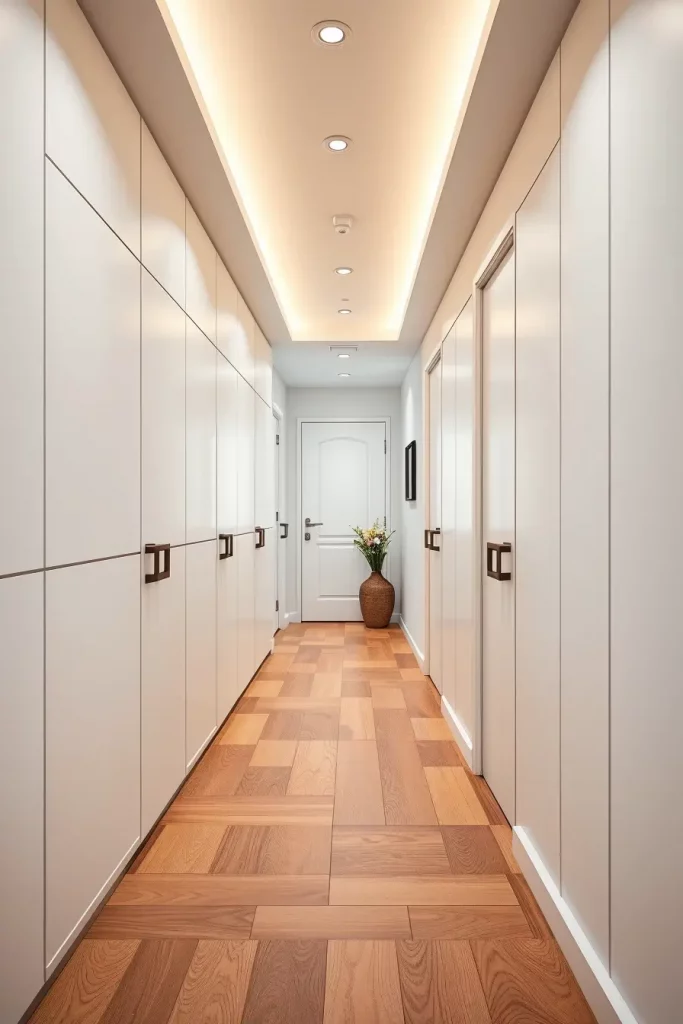
Such intelligent storage solutions excel as interior accents in contemporary as well as minimalist interior design spaces. This system finds its application in compact urban apartments that have limited space. The Dwell magazine discusses integrated paneling systems that deliver both additional storage functionality while providing interior design benefits by presenting continuous, smooth walls.
The idea could be improved by using slatted or fluted panel fronts for texture and by installing ambient lighting strips at the edges to create an upscale appearance.
Display Family Photos in a Linear Layout
A linear presentation of family photos arranged in an organized manner brings sentimental character to narrow hallways without creating visual clutter. This simple decoration idea delivers maximum meaning through its execution. A properly selected display transforms personal pictures into an aesthetic historical collection which enriches both hallway atmosphere and emotional value.
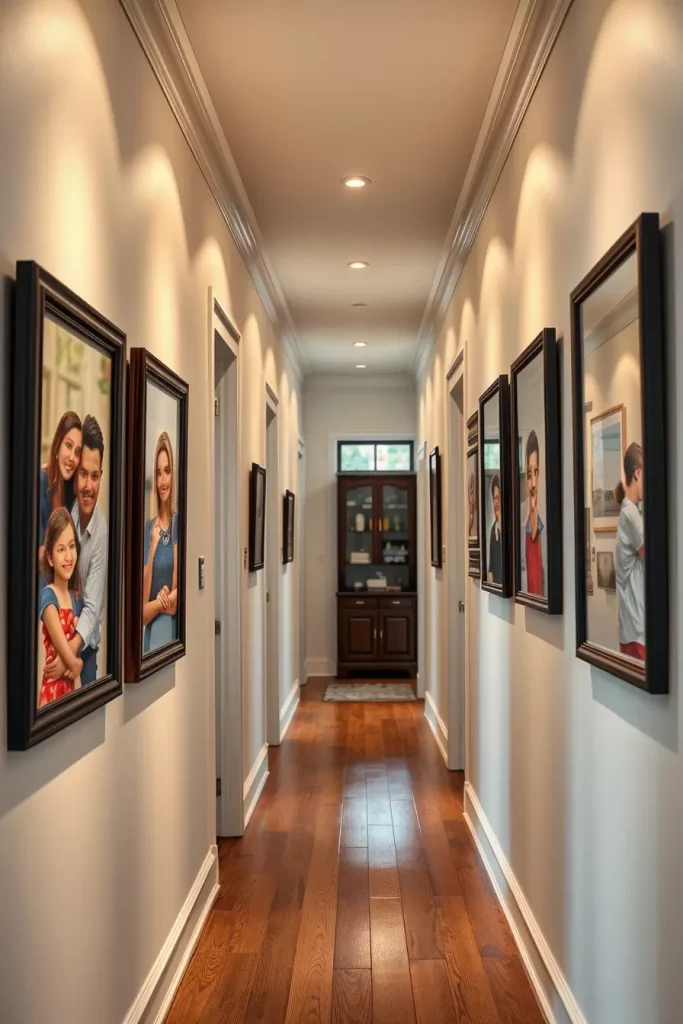
The frames should match in black or white or natural wood to achieve a unified appearance. Place the photos either across the wall at eye level or arrange them in a modern grid formation. Maintaining uniform spacing along with standard framing techniques will create a successful result. Black and white photos and soft color schemes should be used to maintain visual unity.

The client consistently selects this approach because it transforms ordinary passageways into captivating destinations. The visual time sequence of the hallway captivates me as I walk through it. In order to create more effective photo storytelling Better Homes and Gardens recommends using differently colored mats along with small plaques beneath the pictures.
To enhance this concept you should either install a picture light rail above the gallery or use magnetic photo rails for an interchangeable display system.
Style With Monochrome Decor for a Sleek Look
When designing a neat unified space with minimal area I choose to use monochromatic style elements for aesthetic cohesiveness. Narrow hallways become more elegant when decorated with this style. Single-color variations such as greys and whites and earthy neutrals should be used in layered textured elements instead of patterns to achieve this design.
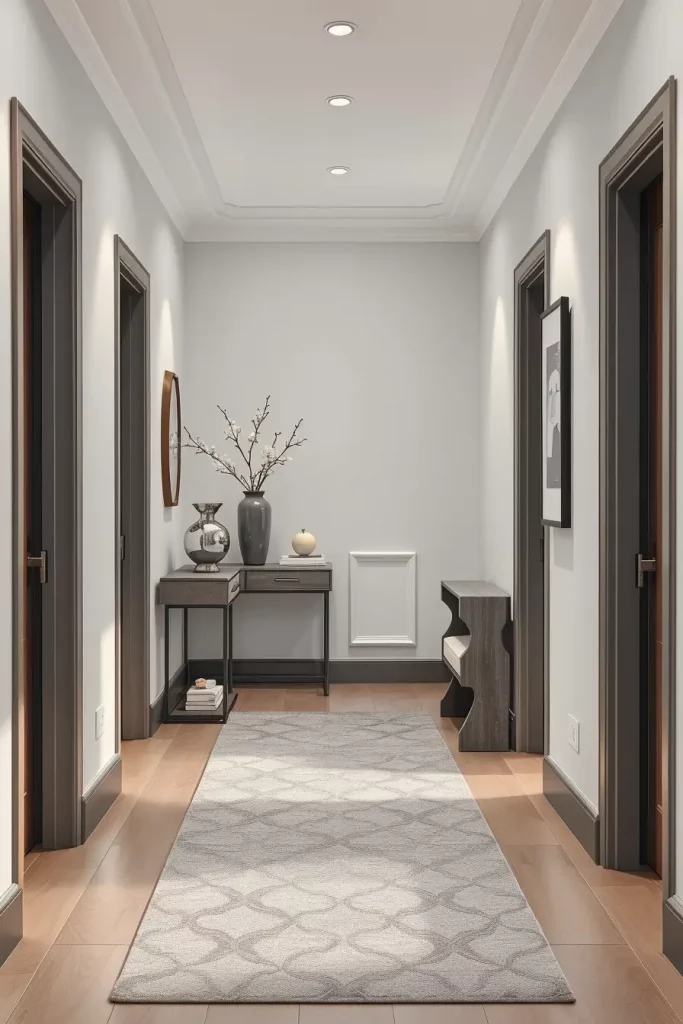
Soft gray walls work best with furniture and decor items that match in tone including a slim console and matte planters and sculptural pieces. Use rugs and wall panels as well as art pieces which maintain the same color family to introduce texture. Glass objects and mirrors provide gentle visual contrast that stays within the chosen color scheme.
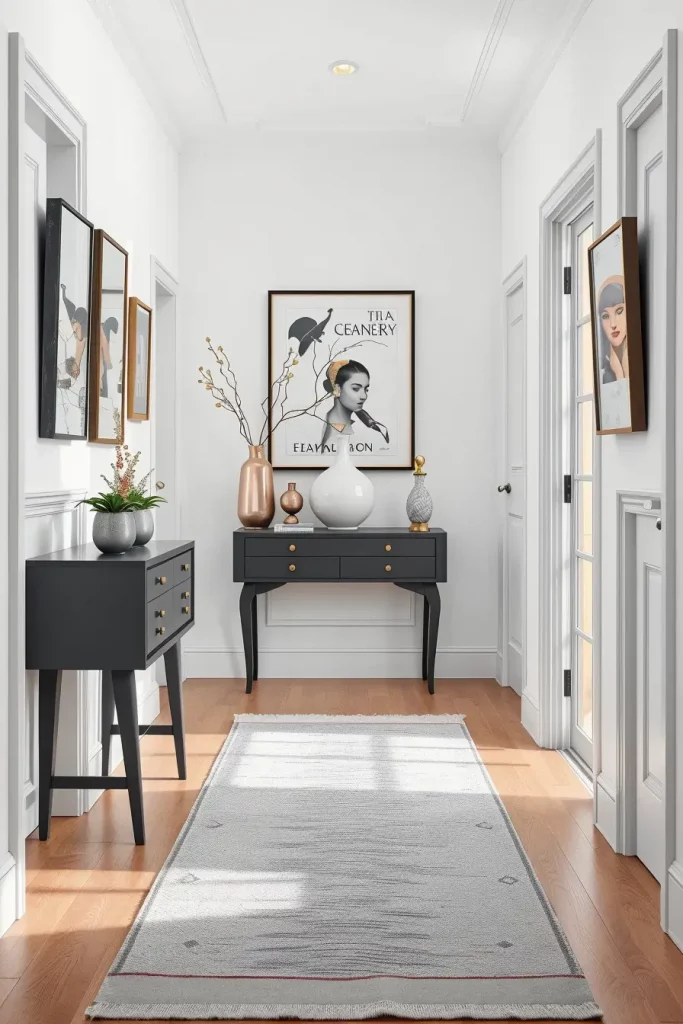
The use of monochrome color schemes helps designers achieve contemporary spa-like designs. The design technique receives widespread recognition from Domino magazine and other interior design publications because it makes spaces appear longer while soothing visual perceptions.
The addition of cove lights or under-console LEDs as indirect lighting will help you highlight shapes while maintaining a distraction-free environment.
Embrace Scandinavian Minimalism for Clean Lines
Scandinavian minimalism stands as the ideal approach to decorate narrow hallways. Minimalist design elements use straight lines and practical items together with organic materials to generate spacious organized rooms. I apply this design approach frequently to achieve a lighter atmosphere through decluttering.
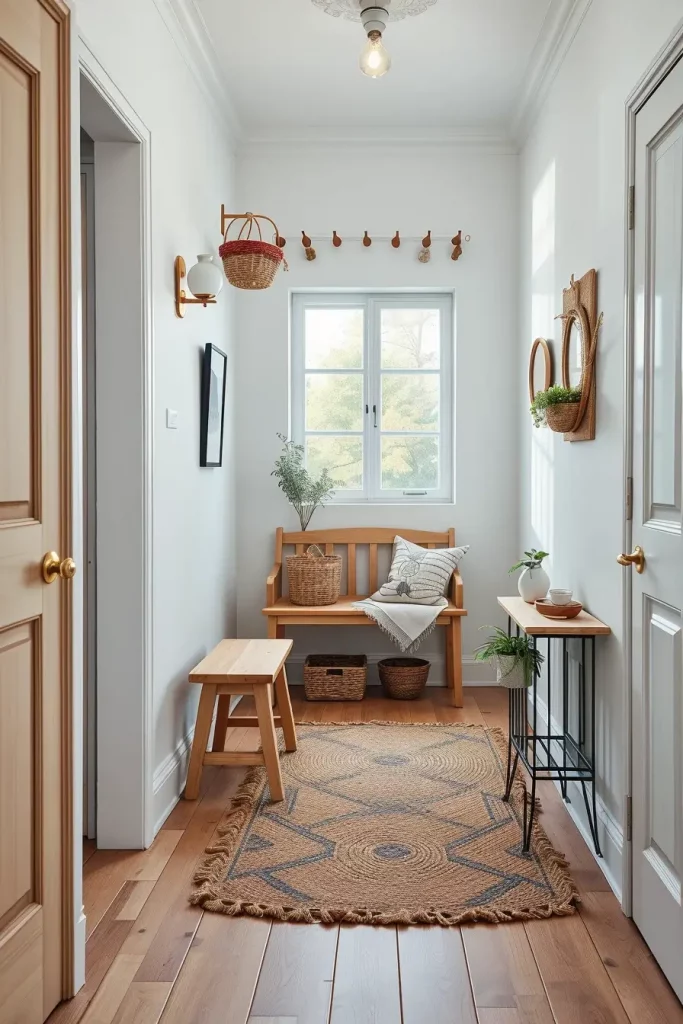
Birch or ash wood in light tones should be used for hallway decorations with white walls and either matte black or soft gray accents. The design should feature only one floating bench or a peg rail or a small basket as furniture pieces. The room gets a tactile touch with a jute runner and warmed up by a ceramic wall sconce.
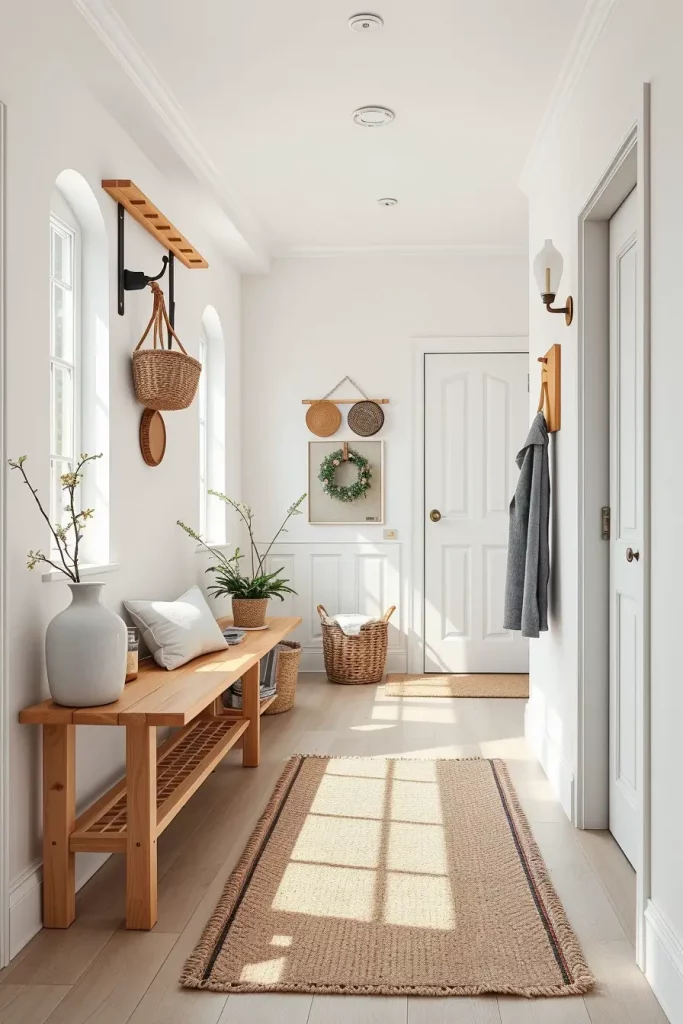
This design choice makes clients happy because it requires low maintenance while delivering a peaceful visual experience. The design style appears regularly in Scandinavian design media while Dezeen recently commended the area-conserving approach which embraces functionality next to attractive aesthetics.
I would complete the area by installing either a small hanging plant or a sculptural wall hook system which combines practicality with organic shapes.
Use Mosaic Tiles on the Floor for Detail
I have discovered that mosaic tiles placed on the floor serve as an excellent method to enhance visual appeal in narrow hallways. The floor application of mosaic tiles brings decorative patterns while maintaining floor space availability. When guests enter the house through the hallway they are immediately struck by an appealing tile pattern that creates a strong first impression. High-traffic areas benefit from mosaic tiles since they present an elegant appearance and maintain their durability together with ease of cleaning.
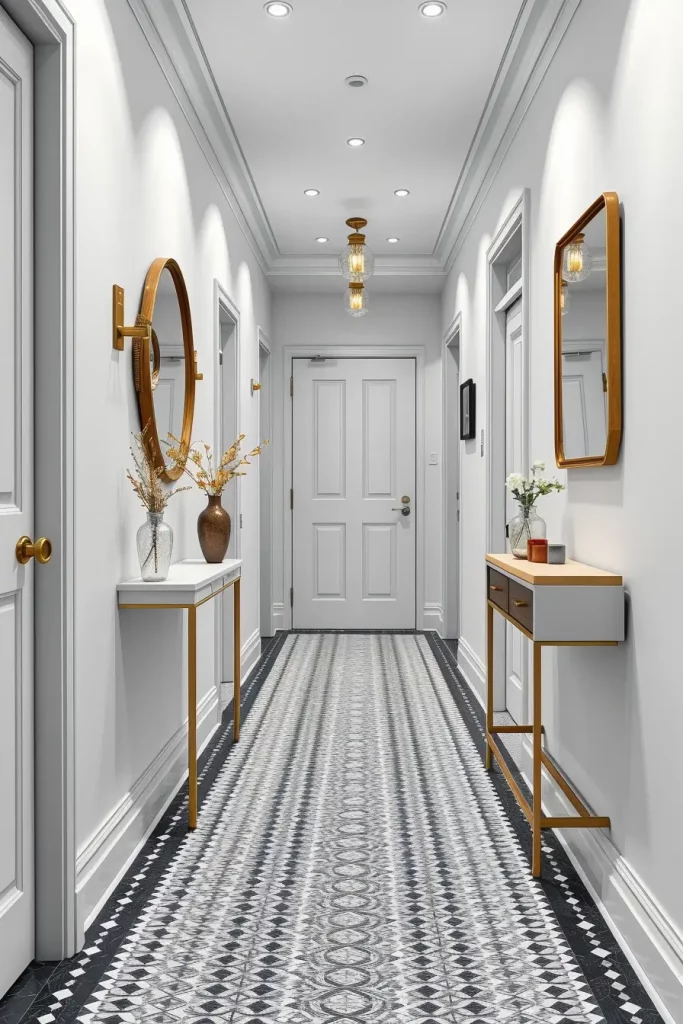
Narrow hallways receive my preference for geometric or floral designs as their motifs. Black and white checkerboard tiles or encaustic-style mosaic tiles combine to create an elegant bold appearance. The correct placement of the pattern from end to end creates an illusion of increased hallway length. The flooring should be accompanied by neutral walls and basic baseboards and a thin console if there is enough space available. The tiles function as the primary design elements in this space which means supporting decor elements should remain basic.

Clients continuously express surprise when they observe how picking the right floor tile style elevates the entire hallway appearance. The dedicated interior designer Emily Henderson explains that compact rooms can produce major visual experiences with correctly chosen design elements. I wholeheartedly agree. The installation of mosaic tile flooring transforms a space into an elevated area even with basic changes.
I would implement low-profile LED lighting systems that would shine on the tilework while also providing pathway illumination during nighttime. The small enhancement creates a perfect balance between practicality and visual attractiveness.
Add a Pop of Color With Painted Doors
I find painting interior doors in intense saturated colors to be an excellent method for energizing narrow hallways. This strategy enables you to customize your hallway area in a way that respects its overall balance. The limited wall area makes door painting an effective method to introduce color into the space. This approach creates a fun yet purposeful effect which stands out well against neutral or white hallway walls.
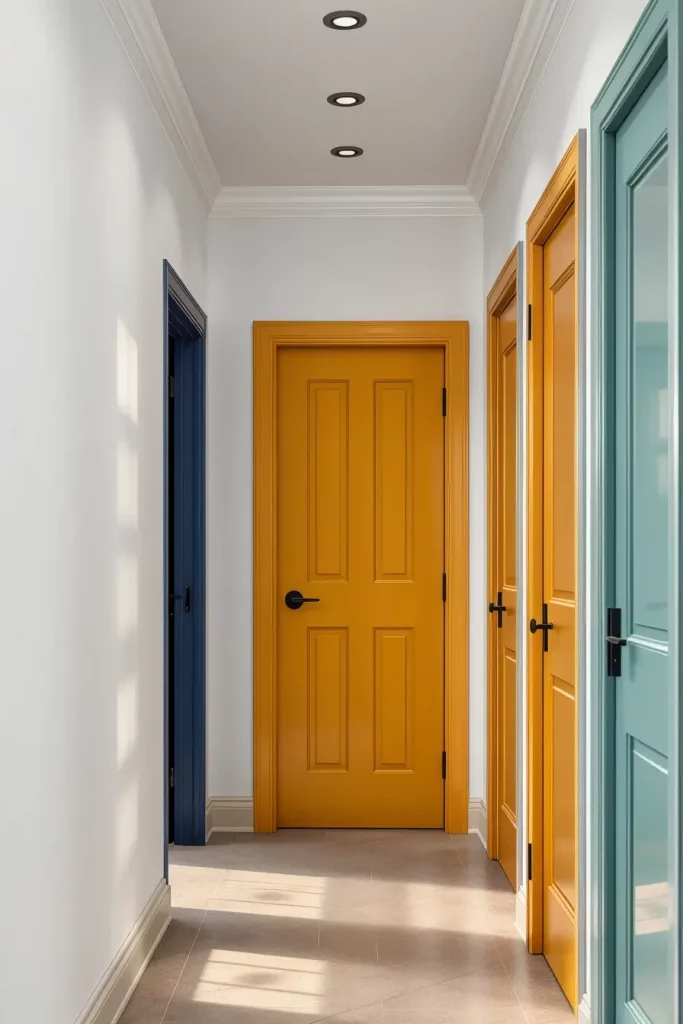
I choose deep navy or olive green or mustard yellow as paint colors for this design approach depending on the existing home palette. The shiny gloss surface creates modern effect by reflecting light while matte finishes draw toward tranquility through their reflective nature. The painted doors stand out as focal points when you maintain a restrained approach to the rest of the hallway through white walls and slim black hardware and minimal art.
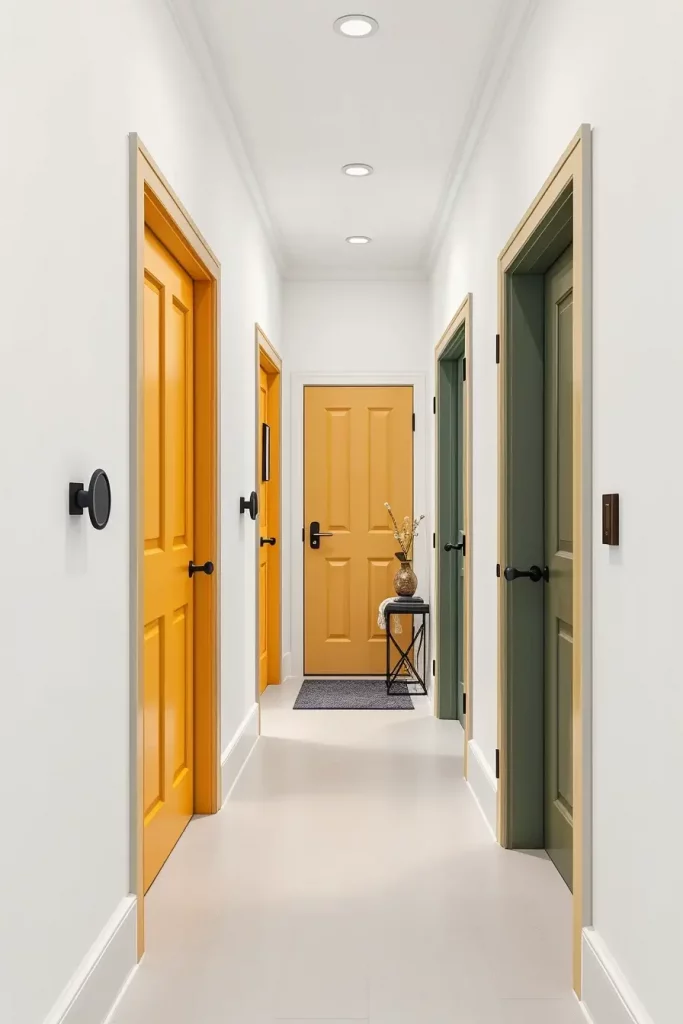
I painted a dull hallway corridor with three earthy shades of terracotta along with sage and slate blue. The hallway received a new animated feeling that made people frequently notice the color scheme. Apartment Therapy suggests this door painting technique as an accessible design move for renters because it creates a big impact while being easy to reverse.
The look can be finished off with small metallic number plaques or enameled labels on the doors to provide both character and functionality for hallways with multiple rooms.
Use Vintage Hooks and Knobs for Character
Functionality needs to match beauty in every narrow hallway design project. The addition of vintage hooks and knobs mounted along the walls stands as one of my preferred decorative elements. This valuable feature enables proper coat and bag storage in addition to delivering decorative visual enhancement as well as textural interest to the space. Vintage hardware serves as an excellent addition to classic homes and modern apartments because it creates a connection to history that brings charm.
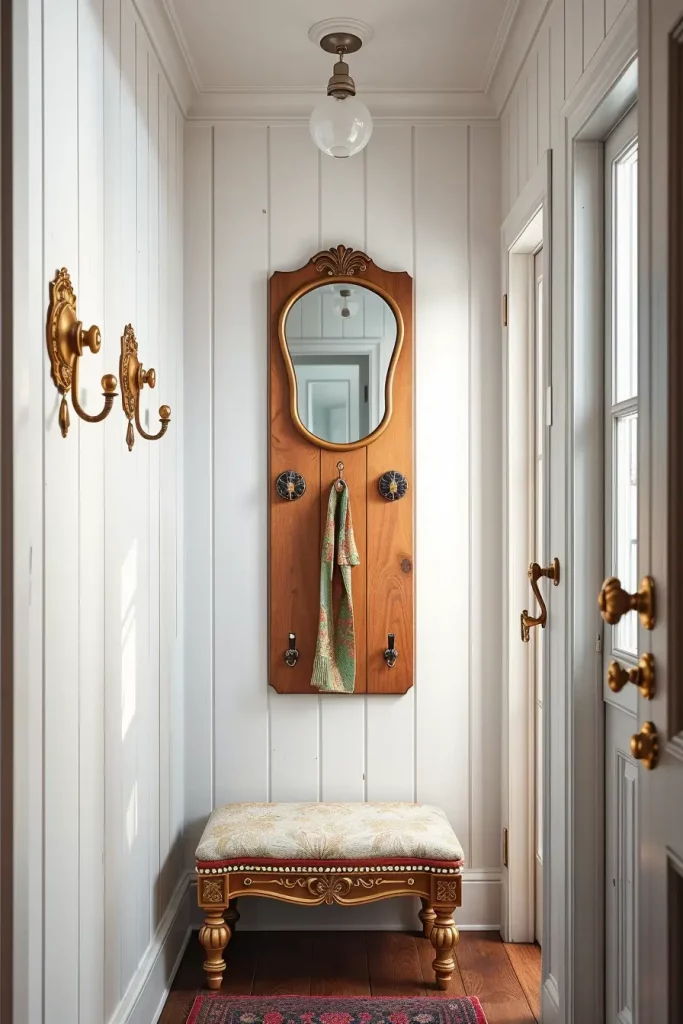
I purchase aged brass, iron and porcelain hooks from antique stores together with specialty shops. To create an easy alignment system use wooden boards as mounts for these vintage hooks. The installation of whimsical-shaped or etched-design knobs in staggered arrangements will create visual interest by breaking up linear patterns. These elements provide practical benefits while functioning as decorative pieces mainly in residences with no distinct entry point.
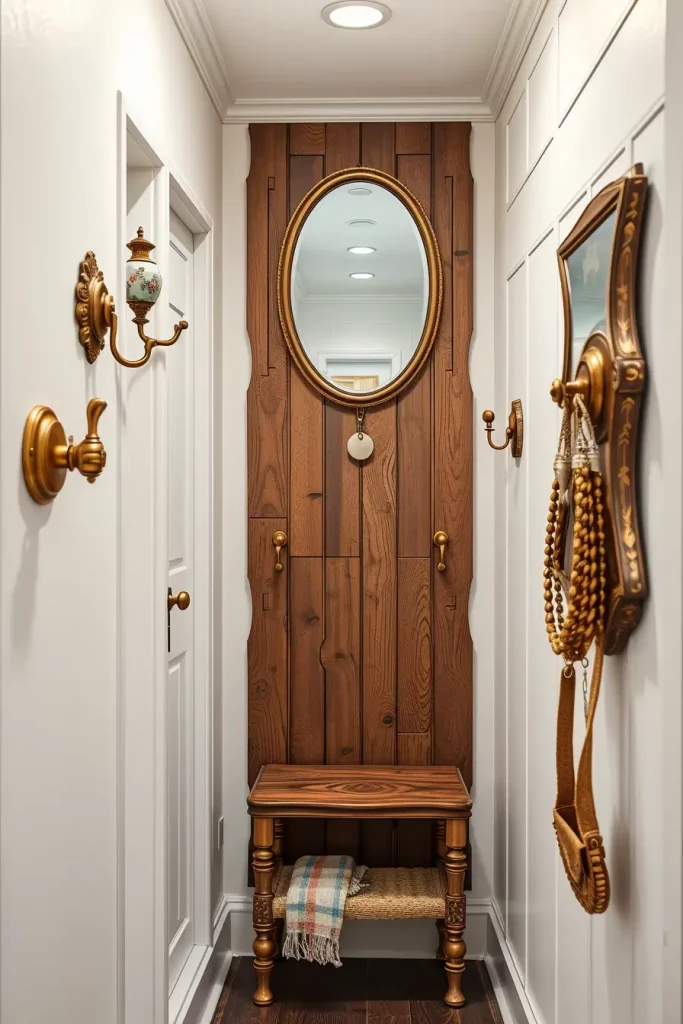
The vintage hardware look which develops from collection over time receives positive feedback from clients. I used mismatched antique hooks at eye level alongside an old mirror placed above a shoe cabinet during my personal project. The hallway acquired instant character through this placement. Architectural Digest showcased the ability of heritage elements to “anchor a home’s personality” by anchoring even non-glamorous corners of a house.
I would enhance the vintage hardware setup by adding either a classic runner rug or rustic bench underneath it as long as the space allows for it to create unified design while maintaining easy access.
Make the End of the Hall a Focal Point
The area directly at the end of a narrow hallway remains unused by most people. The end wall should not remain empty because it needs to be the central design element. The wall at the hallway’s end serves perfectly to attract viewer attention which creates depth and purposeful direction. The application of this technique works best in hallways that do not have natural lighting or architectural features.
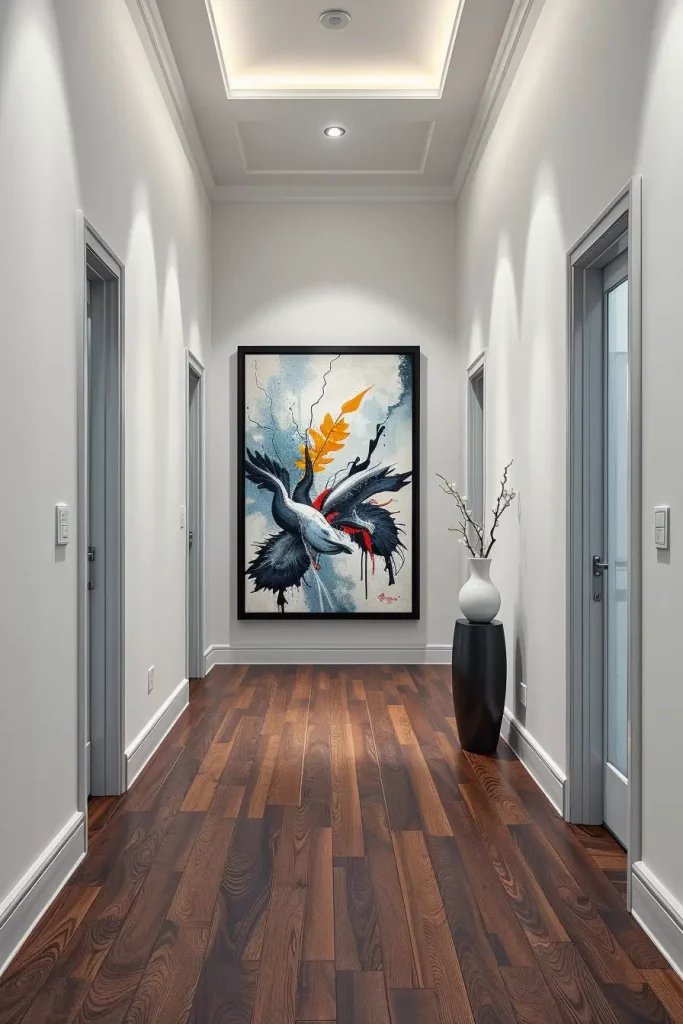
I prefer to use a dramatic artwork such as a big canvas or sculptural mirror as my preferred design element. Place a narrow base with an artistic vase or decorative ceramic piece on it. When positioned at the hallway end the wall works as a spatial grounding element which establishes purpose for the entire corridor. Bold-designed artwork should always use restricted color schemes to create maximum impact without becoming overpowering to viewers.
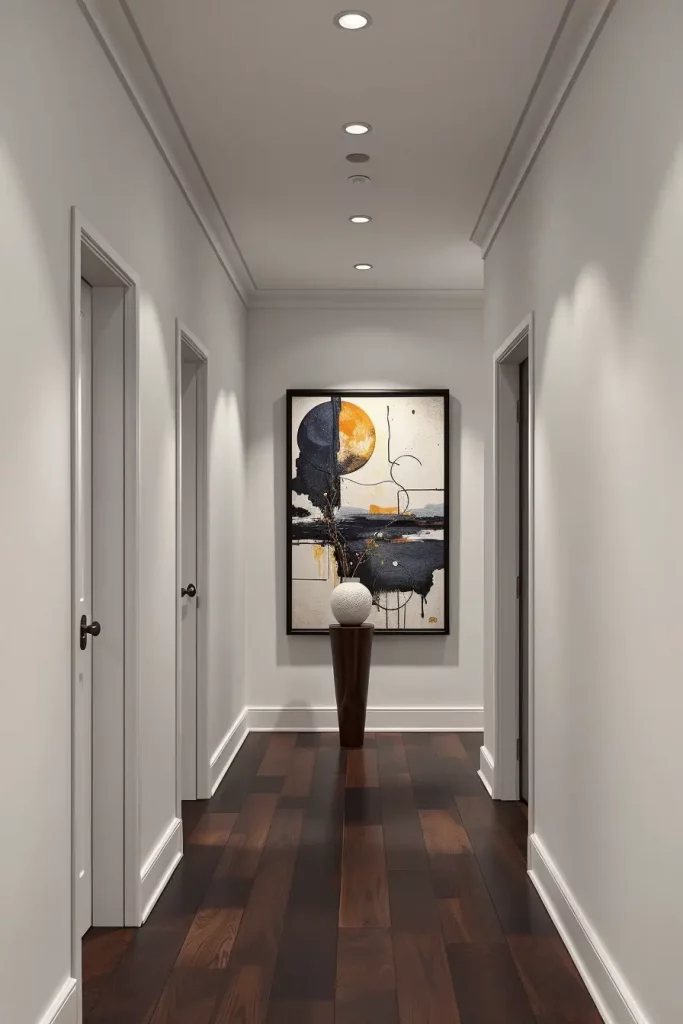
During my design we installed a black-framed tall mirror that received illumination from an LED picture light at the hallway’s conclusion. The installation of this mirror together with its black frame brought elegant style while returning illumination to the hallway. Narrow hallways benefit greatly from endcaps according to Studio McGee designers and this strategy has proven successful every time I use it.
I would enhance this concept by installing a narrow shelf or integrated storage space for seasonal decorations and fresh plants which would introduce yearly visual changes.
